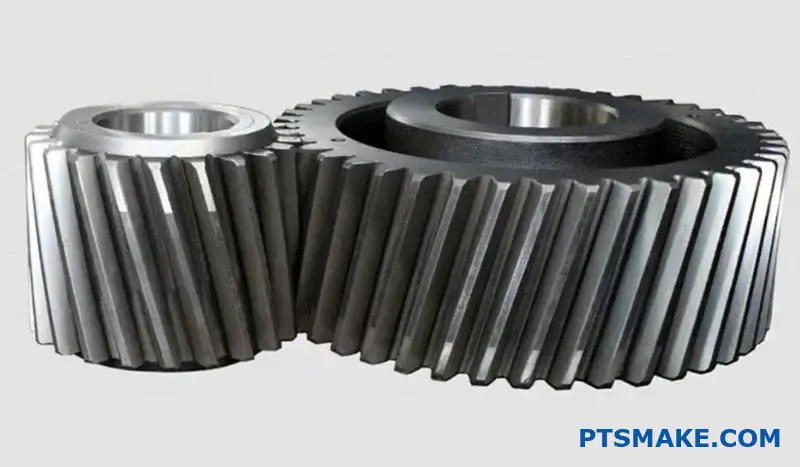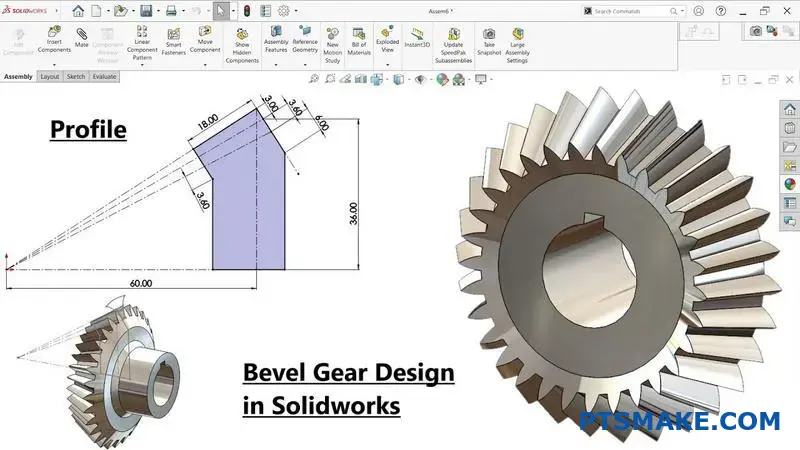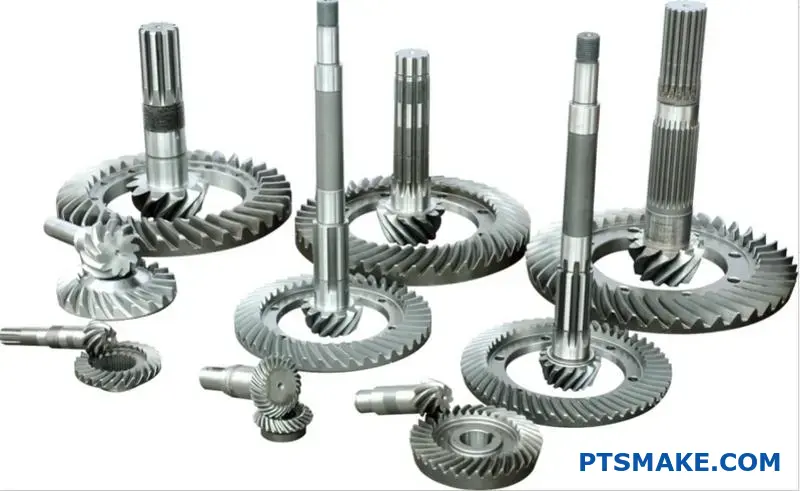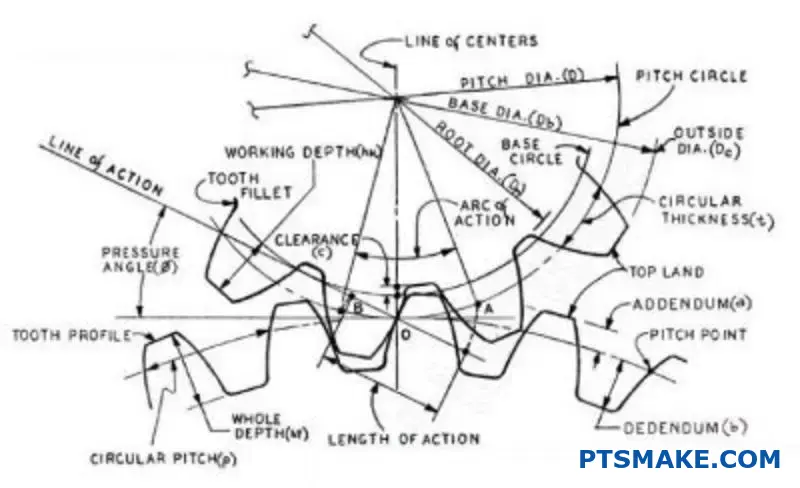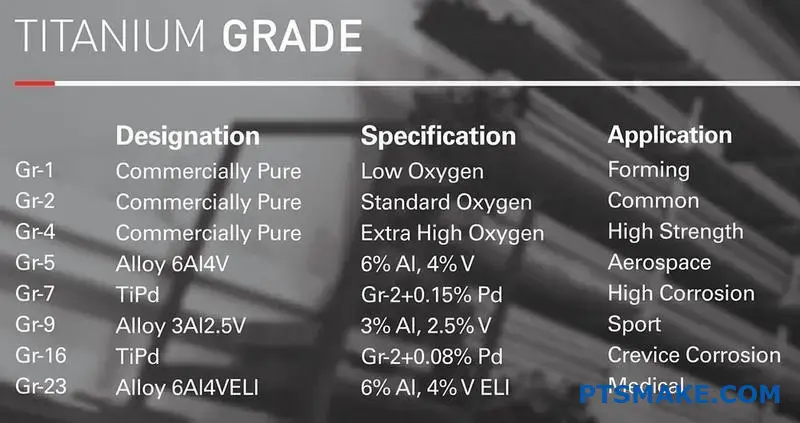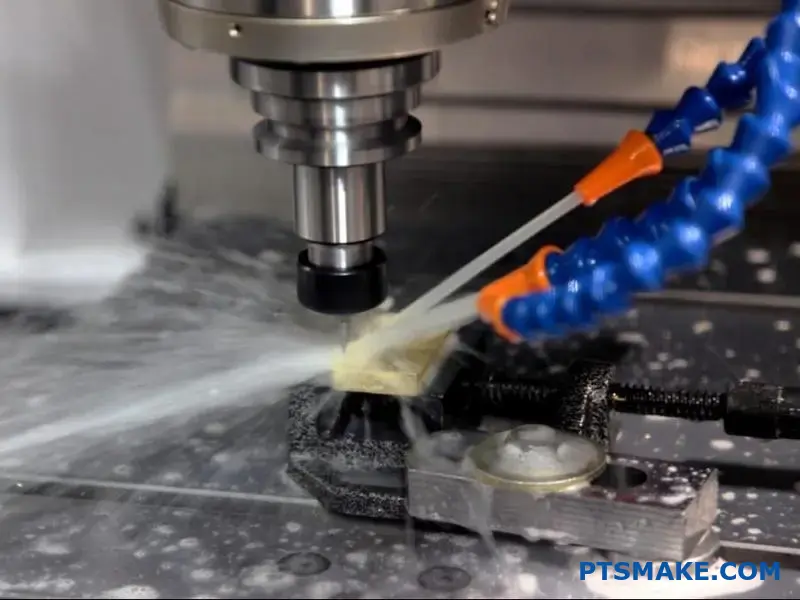Are you noticing poor handling, excessive tire wear, or strange noises when driving over bumps? Your stock control arms might be wearing out or limiting your vehicle’s performance. Many drivers struggle with these issues but continue using factory components, unaware that better options exist.
Aftermarket control arms offer improved durability, enhanced performance, better adjustability, and increased strength compared to stock components. They’re typically made from stronger materials like billet aluminum or chromoly steel, allowing for better handling, reduced vibration, and extended component life.
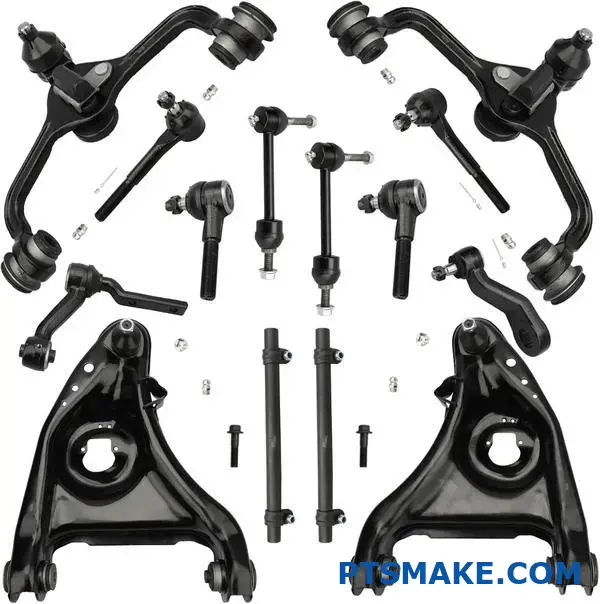
I’ve installed hundreds of aftermarket control arms for our customers over the years. Trust me when I say the difference is immediately noticeable. If you’re considering upgrading your suspension system, keep reading to discover why aftermarket control arms might be one of the best investments for your vehicle’s performance and handling.
Are Aftermarket Control Arms Legal?
Ever wondered if those high-performance aftermarket control arms you’ve been eyeing might land you in legal trouble? Many car enthusiasts find themselves caught between wanting to upgrade their suspension and fearing potential violations of vehicle modification laws that could result in failed inspections or even citations.
Aftermarket control arms are generally legal in most states, but their legality depends on specific state regulations, proper certification, and whether they maintain your vehicle’s safety standards. DOT-approved or FMVSS-compliant parts are typically legal, while extreme modifications that significantly alter ride height or geometry may violate state vehicle codes.
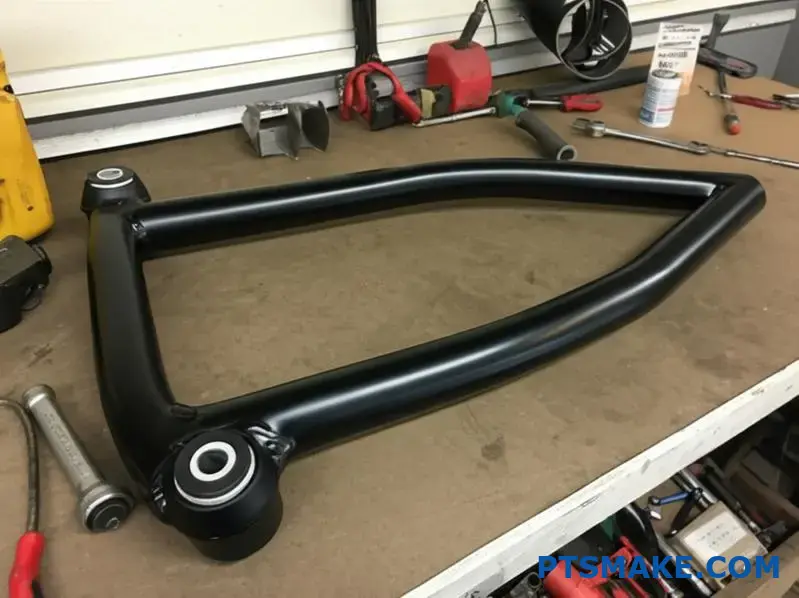
Understanding Control Arms and Their Function
Control arms play a crucial role in your vehicle’s suspension system, connecting the chassis to the steering knuckles and wheel hubs. These components allow wheels to move up and down while maintaining proper alignment. As someone who’s worked with suspension systems for over 15+ years, I can tell you that they’re fundamental to handling, ride comfort, and safety.
The main functions of control arms include:
- Maintaining wheel alignment during suspension travel
- Absorbing road impacts and reducing vibrations
- Supporting vehicle weight and handling forces
- Allowing controlled vertical wheel movement while restricting unwanted movement
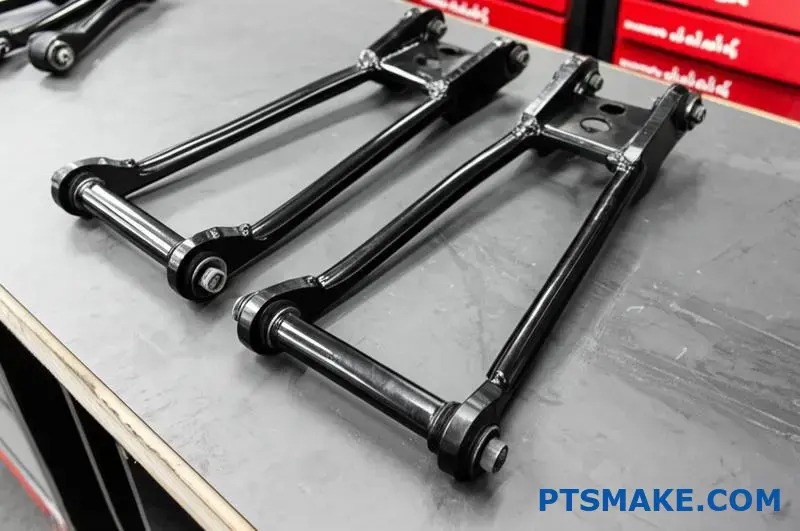
While factory control arms are designed to balance performance, comfort, and manufacturing costs, aftermarket options often prioritize specific characteristics like durability, adjustability, or performance. This is where legal questions typically arise.
Legal Considerations for Aftermarket Control Arms
Federal vs. State Regulations
When determining if aftermarket control arms are legal, you need to understand both federal and state regulations:
| Regulatory Level | Key Requirements | Enforcement |
|---|---|---|
| Federal (NHTSA) | FMVSS compliance, DOT approval | Manufacturer requirements, recalls |
| State | Vehicle inspections, ride height laws, frame modification rules | Registration, roadside enforcement, inspections |
| Local | Noise ordinances, specific modification restrictions | Police enforcement, citations |
The Federal Motor Vehicle Safety Standards (FMVSS) establish baseline requirements that manufacturers must meet, but individual states have significant leeway in creating and enforcing their own vehicle modification laws. At PTSMAKE, we regularly help clients navigate these requirements when designing custom components.
Key Factors Affecting Legality
Several factors determine whether your aftermarket control arms are street-legal:
Certification and Compliance
Aftermarket parts with proper certification are typically legal in most jurisdictions. Look for:
- DOT approval
- FMVSS compliance certification
- ISO certification (not legally required but indicates quality standards)
- SEMA approval or certification
Many reputable manufacturers invest in proper testing and certification. These aren’t just marketing claims—they provide legal protection and ensure safety.
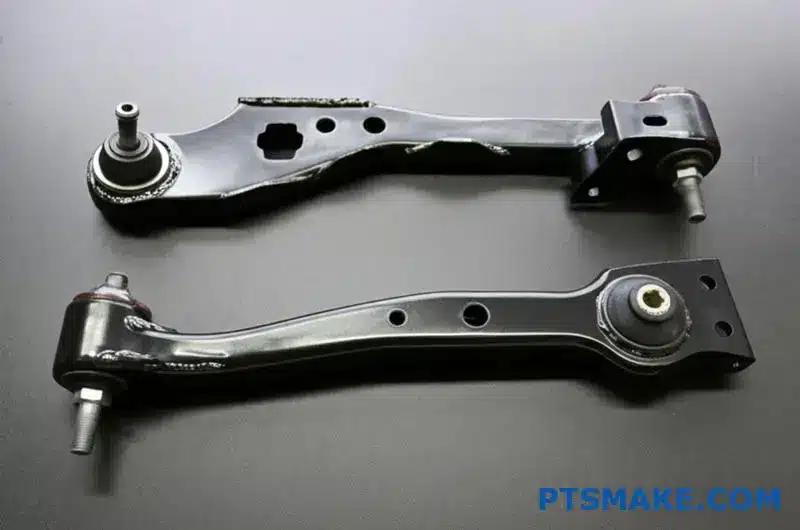
Modification Extent
The degree of modification also influences legality:
- Direct OEM replacements: Aftermarket control arms that maintain factory geometry and specifications are generally legal everywhere.
- Mild modifications: Slightly adjustable control arms that allow for minor alignment changes usually pass inspections.
- Extreme modifications: Components that dramatically alter suspension geometry, significantly change ride height, or affect handling characteristics may violate vehicle codes.
In my experience working with custom components, the line between legal and illegal often comes down to how drastically the part changes your vehicle’s original design and safety characteristics.
Vehicle Use Classification
How your vehicle is classified and used matters:
- Street-legal daily drivers: Must comply with all applicable regulations
- Off-road only vehicles: Often exempt from many requirements
- Track-use vehicles: May have different standards if not driven on public roads
- Show cars: Some jurisdictions offer special provisions for show vehicles
Common Legal Issues with Aftermarket Control Arms
The most frequent legal problems I’ve seen with aftermarket control arms1 include:
- Excessive ride height changes: Many states have minimum and maximum bumper or chassis height requirements.
- Compromised structural integrity: Modifications that weaken the vehicle’s structure are typically illegal.
- Poor alignment specs: Control arms that put alignment outside of safe parameters can be deemed unsafe.
- Missing certification: In states with strict inspection programs, non-certified parts may automatically fail.
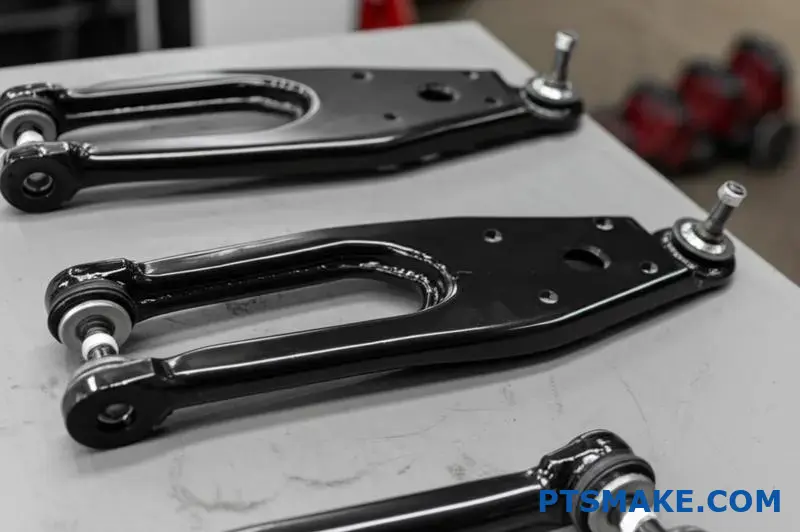
How to Ensure Your Aftermarket Control Arms Are Legal
Based on my industry experience, I recommend these steps to stay on the right side of the law:
- Research your state’s specific vehicle modification laws before purchasing.
- Choose quality components from reputable manufacturers that provide proper documentation.
- Maintain reasonable modifications that don’t dramatically alter your vehicle’s handling characteristics.
- Keep documentation of all parts installed, including certification papers.
- Consider professional installation with alignment verification afterward.
When we manufacture custom components at PTSMAKE, we always emphasize the importance of compliance with local regulations, even when creating high-performance parts. The goal should always be improving your vehicle’s performance without compromising safety or legality.
Remember, vehicle inspectors and law enforcement typically focus on safety concerns rather than targeting enthusiasts. By choosing quality parts and maintaining reasonable modifications, you can enjoy improved performance while avoiding legal complications.
Are Aftermarket Control Arms Worth It?
Have you been feeling that vague dissatisfaction with your vehicle’s handling or stability? Maybe you’ve noticed increased vibration over bumps or your tires wearing unevenly. These symptoms often point to suspension components that aren’t performing optimally, yet many drivers hesitate to upgrade beyond factory specifications.
Aftermarket control arms are worth the investment for enthusiasts seeking improved handling, adjustability, and durability. These components typically offer better build quality, stronger materials, and performance-oriented designs compared to OEM parts. However, the value depends on your specific driving needs, vehicle application, and budget constraints.

Understanding the Value Proposition of Aftermarket Control Arms
Control arms serve as critical links in your vehicle’s suspension system, connecting the frame to the steering knuckles while allowing controlled vertical wheel movement. As someone who’s helped numerous clients upgrade their suspension systems, I’ve seen firsthand how aftermarket control arms can transform a vehicle’s performance characteristics.
Material Benefits and Construction Advantages
The most immediate difference between factory and aftermarket control arms lies in their construction. OEM control arms are typically designed with cost and mass production in mind, while aftermarket options prioritize performance and durability.
Here’s what separates quality aftermarket control arms from their stock counterparts:
| Feature | OEM Control Arms | Aftermarket Control Arms |
|---|---|---|
| Materials | Stamped steel or cast iron | Forged aluminum, billet aluminum, or chromoly steel |
| Design | Fixed geometry, non-adjustable | Often adjustable, optimized geometry |
| Bushings | Rubber (prioritizes comfort) | Polyurethane or spherical bearings (prioritizes performance) |
| Strength | Adequate for factory specifications | Reinforced for high-stress applications |
| Weight | Generally heavier | Often lighter (aluminum versions) |
I’ve found that vehicles equipped with properly engineered aftermarket control arms demonstrate noticeably improved response, particularly during cornering and over irregular surfaces. The upgraded materials resist flexing under load, maintaining your alignment settings even under stress.

Performance Improvements Worth Considering
When clients ask me if aftermarket control arms are worth it, I typically highlight these performance benefits:
Enhanced Handling Precision
Factory control arms often incorporate soft rubber bushings that prioritize ride comfort over handling precision. These bushings flex and deform under load, creating inconsistent handling characteristics. Aftermarket control arms typically use stiffer polyurethane bushings or even spherical bearings that eliminate unwanted movement.
The result is:
- More immediate steering response
- Consistent handling characteristics
- Better feedback through the steering wheel
- Reduced body roll during cornering maneuvers
For performance driving enthusiasts, this increased precision can translate to faster lap times and greater driver confidence.
Adjustability for Personalized Setup
One of the most valuable features of premium aftermarket control arms is adjustability. While factory arms lock you into predetermined geometry, adjustable control arms allow you to:
- Fine-tune camber angles for optimized tire contact
- Correct alignment issues on lowered vehicles
- Adapt the suspension to specific driving conditions
- Compensate for other modifications like wider wheels
I’ve helped customers at PTSMAKE design custom control arms with precise adjustability specifications, enabling them to achieve handling characteristics that would be impossible with stock components.
Increased Durability and Longevity
Quality aftermarket control arms often significantly outlast their OEM counterparts, especially in demanding applications. The superior materials and construction methods result in components that:
- Resist bending under heavy loads
- Maintain proper alignment specs longer
- Handle off-road abuse better
- Survive track day stresses
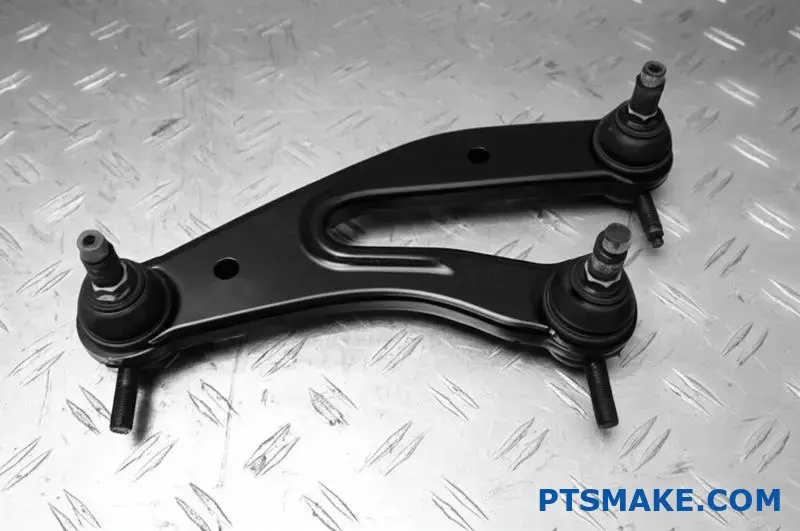
When Aftermarket Control Arms Make Financial Sense
Despite their benefits, aftermarket control arms represent a significant investment. Here’s my perspective on when they’re worth the cost:
Performance-Focused Applications
If you’re an enthusiast who:
- Participates in track days or autocross events
- Drives aggressively on mountain roads
- Has modified your vehicle with other performance upgrades
- Values handling precision over maximum comfort
Then aftermarket control arms can be one of the most impactful suspension upgrades you can make. The improved handling characteristics are immediately noticeable and complement other performance modifications.
Modified Suspension Systems
For vehicles with lowered suspension or other geometry changes, aftermarket control arms often become a necessity rather than a luxury. Factory control arms can create these problems in modified vehicles:
- Improper alignment angles
- Premature bushing wear
- Limited suspension travel
- Binding at extreme articulation
In these cases, adjustable aftermarket control arms allow you to restore proper geometry and prevent expensive tire wear and handling problems.
Off-Road Applications
For off-road enthusiasts, heavy-duty aftermarket control arms provide:
- Additional ground clearance
- Increased articulation
- Better impact resistance
- Protection against bending during obstacle navigation
When traversing challenging terrain, the added strength of reinforced control arms can prevent catastrophic failures that would otherwise leave you stranded.
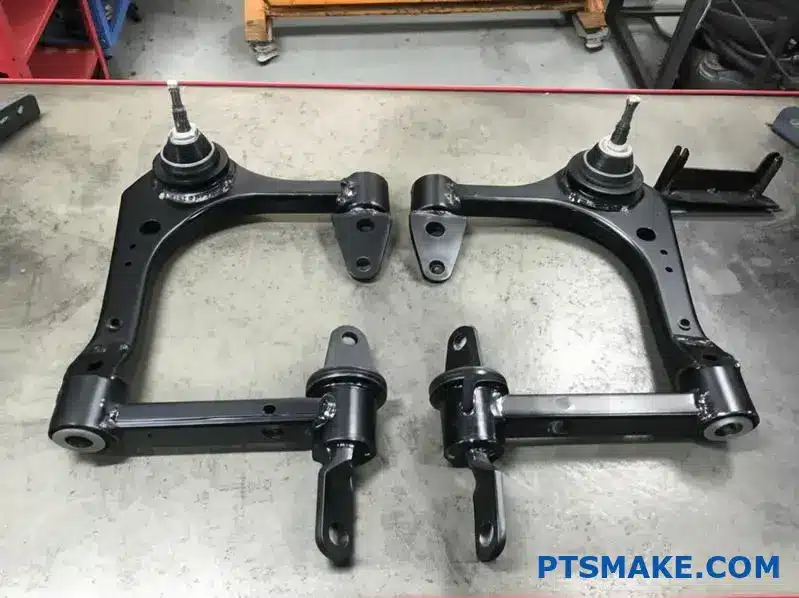
Potential Drawbacks to Consider
In the interest of providing balanced advice, I should note that aftermarket control arms aren’t always the right choice for everyone. Some potential downsides include:
- Increased NVH (Noise, Vibration, Harshness): Stiffer bushings transmit more road feedback into the cabin
- Installation complexities: Some designs require additional modifications or professional installation
- Compatibility issues: Not all aftermarket arms maintain proper geometry clearances2 with other components
- Cost considerations: Quality aftermarket control arms can cost significantly more than OEM replacements
For daily drivers where comfort is the priority, the performance benefits may not justify these tradeoffs. I always advise clients to consider their actual driving needs rather than simply assuming "aftermarket" means "better."
Making the Right Decision for Your Vehicle
After working with suspension systems for over 15 years, I’ve learned that the "worth it" question depends entirely on your specific situation. Consider these factors:
- What are your performance goals?
- Is your vehicle modified in ways that affect suspension geometry?
- Do you drive in conditions that stress OEM components beyond their design limits?
- Are you prepared for potential changes in ride comfort?
If you’re considering aftermarket control arms, I recommend researching options specifically engineered for your vehicle model. Universal designs rarely provide the same benefits as model-specific components that account for your vehicle’s unique suspension characteristics.
In many cases, we’ve helped customers design custom control arms that address specific needs that off-the-shelf products couldn’t meet. This personalized approach ensures you’re getting exactly what your application requires without unnecessary compromises.
What Is The Difference Between OEM And Aftermarket Control Arms?
Ever found yourself puzzled when shopping for replacement control arms? The sea of OEM versus aftermarket options can be overwhelming. Many vehicle owners struggle to determine which type offers better value, leaving them hesitant to make a decision while their suspension continues to deteriorate.
OEM control arms are manufactured by or for the original vehicle manufacturer to exact factory specifications, while aftermarket control arms are made by third-party companies and often feature different materials, designs, and performance characteristics. The key differences appear in materials, design philosophy, price, and customization options.
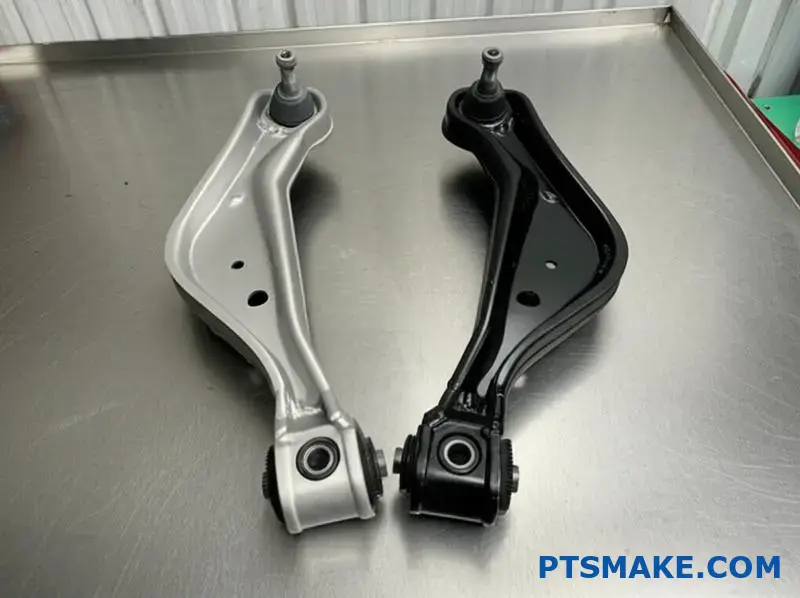
Key Differences Between OEM and Aftermarket Control Arms
Control arms are vital suspension components that connect your vehicle’s frame to the steering knuckles, allowing controlled wheel movement while maintaining proper alignment. Having replaced countless control arms over my 15+ years in the industry, I’ve developed a deep understanding of the crucial differences between OEM and aftermarket options.
Material Composition and Construction
One of the most significant differences between OEM and aftermarket control arms lies in their material composition and construction methods.
OEM control arms are typically made from:
- Stamped steel (most common on economy vehicles)
- Cast iron (on some older vehicles)
- Cast aluminum (on premium vehicles)
These materials are selected to balance cost, durability, and NVH (Noise, Vibration, Harshness) characteristics within the vehicle’s original design parameters.
Aftermarket control arms, however, often utilize:
- Forged aluminum (lighter weight, premium options)
- Billet aluminum (precision-machined for maximum strength)
- Tubular steel (improved strength-to-weight ratio)
- Chromoly steel (high-strength applications)
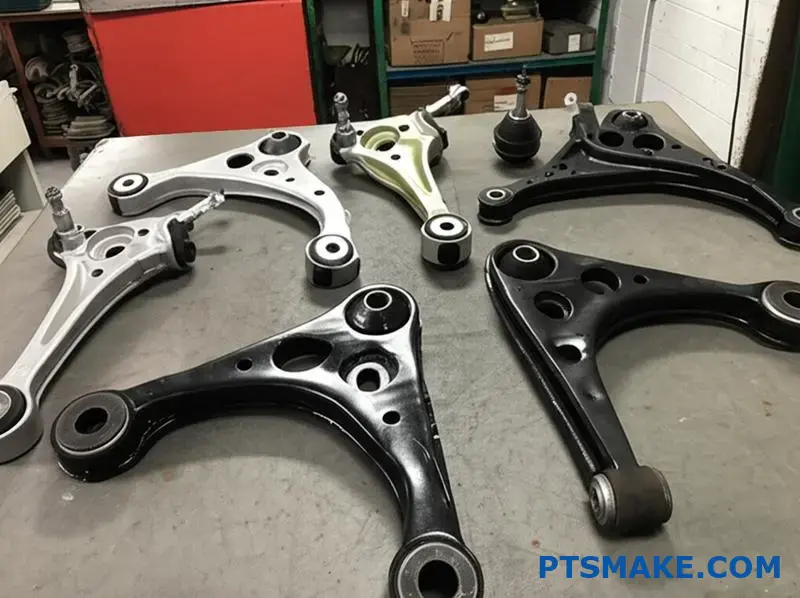
The following table outlines the key material differences:
| Material | Typically Found In | Strength | Weight | Corrosion Resistance | Cost |
|---|---|---|---|---|---|
| Stamped Steel | Economy OEM | Moderate | Heavy | Poor-Moderate | Low |
| Cast Aluminum | Premium OEM | Moderate | Medium | Good | Medium |
| Forged Aluminum | Premium Aftermarket | High | Light | Excellent | High |
| Tubular Steel | Performance Aftermarket | High | Medium | Moderate | Medium-High |
| Chromoly Steel | Heavy-Duty Aftermarket | Very High | Medium-Heavy | Moderate | High |
Design Philosophy and Bushings
The design philosophy represents another major difference between OEM and aftermarket control arms.
OEM control arms are designed with these priorities:
- Meeting vehicle manufacturer specifications
- Balancing comfort and handling
- Cost-effective mass production
- Maintaining consistent ride quality
In contrast, aftermarket manufacturers often design with different priorities:
- Enhanced performance characteristics
- Improved durability for specific applications
- Adjustability for custom setups
- Addressing known weaknesses in OEM designs
This philosophical difference extends to the bushings used in control arms. OEM control arms almost exclusively use rubber bushings that provide:
- Good vibration isolation
- Quiet operation
- Gradual and predictable failure modes
- Comfort-oriented compliance
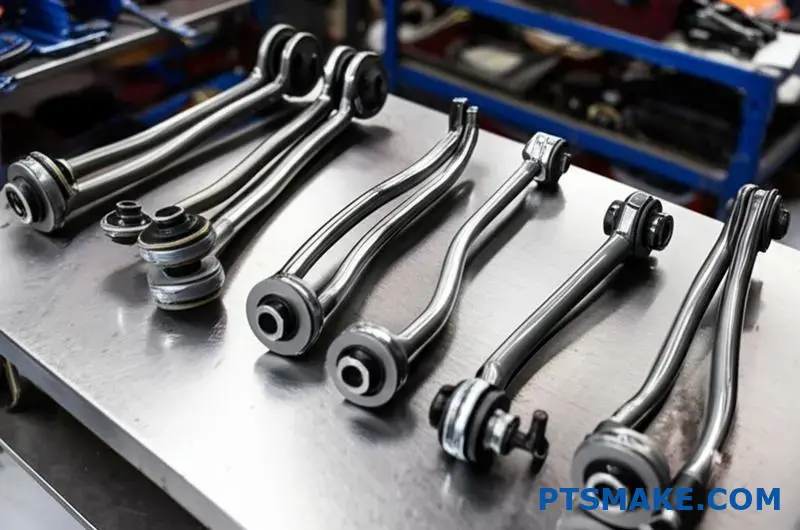
Aftermarket control arms frequently offer alternative bushing options:
- Polyurethane bushings (firmer, more responsive, longer-lasting)
- Delrin bushings (extremely durable, minimal deflection)
- Spherical bearings (zero compliance, maximum precision)
Adjustability Features
Adjustability represents one of the most practical differences between OEM and aftermarket control arms.
OEM control arms are typically fixed in geometry, providing:
- Consistent alignment specifications
- Predictable handling characteristics
- Limited ability to compensate for other modifications
Many aftermarket control arms include adjustability features:
- Camber adjustment points
- Caster adjustment capabilities
- Length adjustment for wheelbase fine-tuning
- Roll center adjustment options
This adjustability proves invaluable when:
- Correcting alignment on lowered vehicles
- Optimizing handling for performance applications
- Compensating for other suspension modifications
- Fixing alignment issues on vehicles with frame damage
Performance Characteristics
The performance characteristics of OEM versus aftermarket control arms vary significantly based on their intended use.
OEM control arms typically provide:
- Predictable, neutral handling
- Comfortable ride quality
- Adequate durability for normal driving
- Compliance tuned to the vehicle’s original suspension design
Aftermarket control arms can offer:
- Sharper steering response
- Reduced body roll during cornering
- Improved wheel control over rough surfaces
- Better durability under high-stress conditions
At PTSMAKE, we’ve manufactured custom control arms for clients requiring specific performance characteristics beyond what’s available off-the-shelf. This customization allows for precise tuning of handling characteristics to match the driver’s preferences and the vehicle’s intended use.
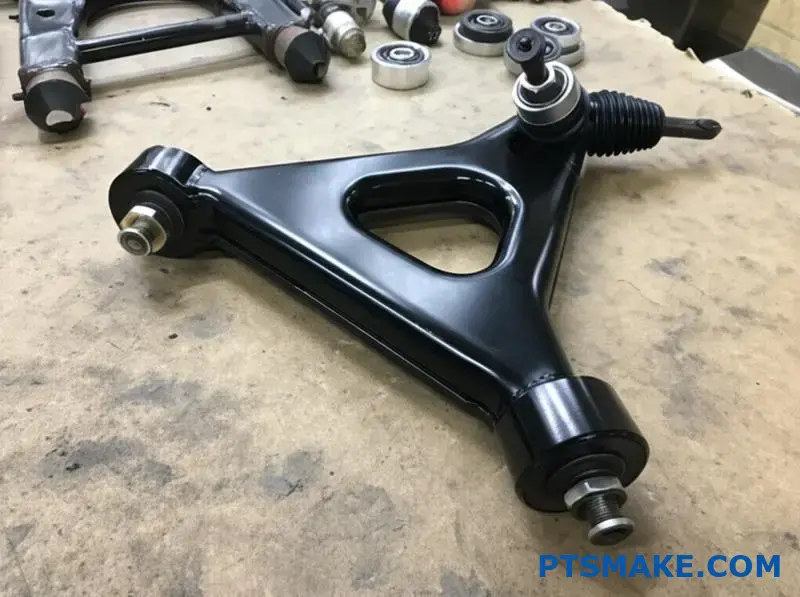
Cost Considerations and Value Proposition
The price difference between OEM and aftermarket control arms can be substantial, but understanding the value proposition requires looking beyond the initial purchase price.
OEM Control Arms
- Higher initial cost than budget aftermarket options
- Guaranteed fit and function
- Often include all necessary hardware
- May have better warranty coverage through dealers
Aftermarket Control Arms
- Wide price range from budget to premium
- Quality varies significantly between manufacturers
- May require additional components (bushings, hardware)
- Often cost less than OEM for budget options
- Premium options typically cost more than OEM
The value calculation depends on your specific needs. For standard replacements on daily drivers, OEM or quality aftermarket direct replacements often provide the best balance. For modified vehicles or performance applications, premium aftermarket control arms with enhanced features may deliver better long-term value despite higher initial costs.
Availability and Compatibility
Availability presents another significant difference between OEM and aftermarket options:
OEM control arms:
- Limited to dealer networks and authorized parts retailers
- May become unavailable for older vehicles
- Typically have longer lead times for special orders
- Guaranteed compatibility with original vehicle specifications
Aftermarket control arms:
- Widely available through multiple distribution channels
- Often available when OEM parts are discontinued
- Generally ship faster than dealer-ordered parts
- Require more research to ensure proper fitment
When working with clients at PTSMAKE, I always emphasize the importance of confirming compatibility, especially with aftermarket options. The wide variety of aftermarket designs means not all options will work equally well with your vehicle’s existing suspension components or other modifications.
Choosing Between OEM and Aftermarket Control Arms
Making the right choice between OEM and aftermarket control arms depends on several factors:
- Vehicle application: Daily driver, track car, off-road vehicle
- Budget constraints: Initial cost vs. long-term value
- Performance goals: Comfort, handling precision, durability
- Modification status: Stock suspension or modified
- Warranty considerations: New vehicles under factory warranty
For unmodified daily drivers where factory handling characteristics are desirable, OEM control arms or direct-replacement aftermarket options usually make the most sense. For performance applications, modified suspensions, or vehicles subjected to harsh conditions, quality aftermarket control arms with appropriate upgrades can provide tangible benefits.
The manufacturing tolerance3 differences between mass-produced OEM parts and precision-engineered aftermarket components can also be a deciding factor for enthusiasts seeking maximum performance and consistency.
Is It Expensive To Fix A Control Arm?
Ever faced that heart-stopping moment when your mechanic mentions control arm replacement? The uncomfortable vibrations, strange clunking noises, and uneven tire wear have finally been diagnosed, but now you’re anxiously wondering if your wallet is about to take a serious hit.
Fixing a control arm typically costs between $150-$400 per arm for parts and $100-$300 for labor, depending on your vehicle make, model, and whether you choose OEM or aftermarket components. Luxury vehicles and those requiring specialized tools or extensive disassembly will fall on the higher end of this range.
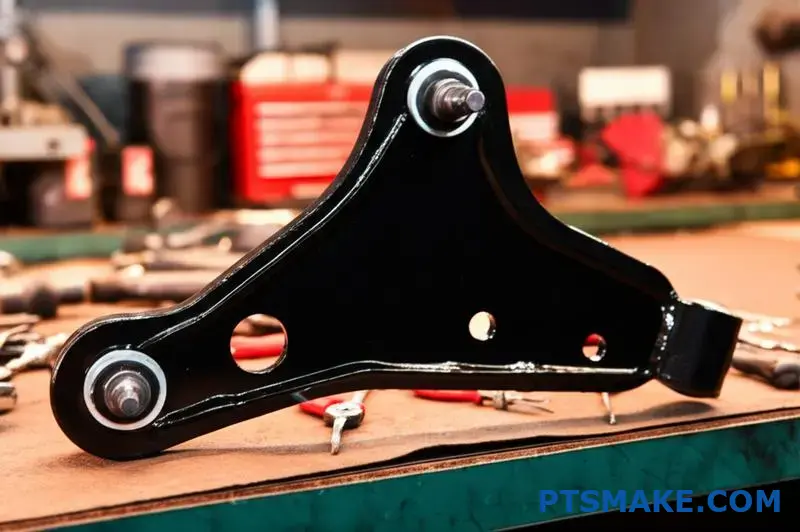
Factors Affecting Control Arm Replacement Costs
When it comes to control arm replacement, several variables dramatically impact the final price you’ll pay. Having overseen hundreds of suspension repairs, I’ve noticed consistent patterns in what drives costs up or down.
Vehicle Make and Model Considerations
The type of vehicle you drive significantly influences control arm replacement costs. Here’s how different vehicle categories typically compare:
| Vehicle Type | Parts Cost Range | Labor Cost Range | Total Cost Range |
|---|---|---|---|
| Economy Cars | $100-$250 | $80-$200 | $180-$450 |
| Mid-Range Sedans/SUVs | $150-$350 | $100-$250 | $250-$600 |
| Luxury Vehicles | $300-$800+ | $150-$400 | $450-$1,200+ |
| Heavy-Duty Trucks | $200-$500 | $150-$350 | $350-$850 |
Luxury vehicles often require specialty parts that come at premium prices. For instance, European luxury brands typically use more complex control arm designs with integrated ball joints and sophisticated bushings that can’t be replaced separately, forcing you to replace the entire assembly.
American and Japanese economy vehicles generally feature simpler designs with more affordable replacement parts. In my experience working with clients at PTSMAKE, we’ve seen aftermarket solutions for these vehicles offer particularly good value.
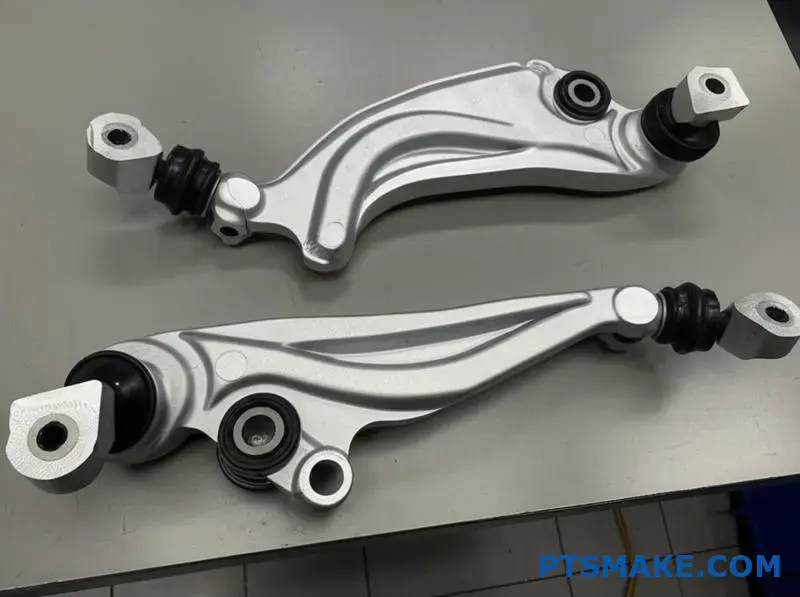
OEM vs. Aftermarket Parts
The choice between OEM (Original Equipment Manufacturer) and aftermarket control arms represents one of the biggest cost variables:
- OEM control arms: Made to exact factory specifications, typically costing 30-50% more than standard aftermarket options but offering guaranteed fitment and quality
- Premium aftermarket control arms: Often made from higher-quality materials than OEM with improved designs, priced similarly to OEM parts
- Standard aftermarket control arms: Generally 30-50% less expensive than OEM, with varying quality
- Economy aftermarket control arms: Can be 50-70% cheaper than OEM, but often with significantly reduced durability
While OEM parts provide peace of mind regarding quality and fitment, I’ve found that reputable aftermarket brands often offer comparable or superior quality at more competitive prices. For performance applications, premium aftermarket control arms may actually outperform OEM components while offering better value.
Labor Costs and Complexity
Labor represents a substantial portion of control arm replacement costs. The complexity of the job varies significantly based on:
- Suspension design: MacPherson strut suspensions are typically easier to work on than double-wishbone designs
- Rust and corrosion: Vehicles from regions using road salt often require additional labor to free seized bolts
- Additional components: Some vehicles require removal of numerous components to access control arms
- Alignment requirements: Nearly all control arm replacements require wheel alignment afterward, adding $80-$150 to total costs
Some modern vehicles have control arms integrated with other components, requiring more extensive disassembly and increasing labor costs. I’ve worked on luxury SUVs where accessing the rear control arms required removing exhaust components, driveshafts, and multiple crossmembers—turning a seemingly simple job into several hours of labor.
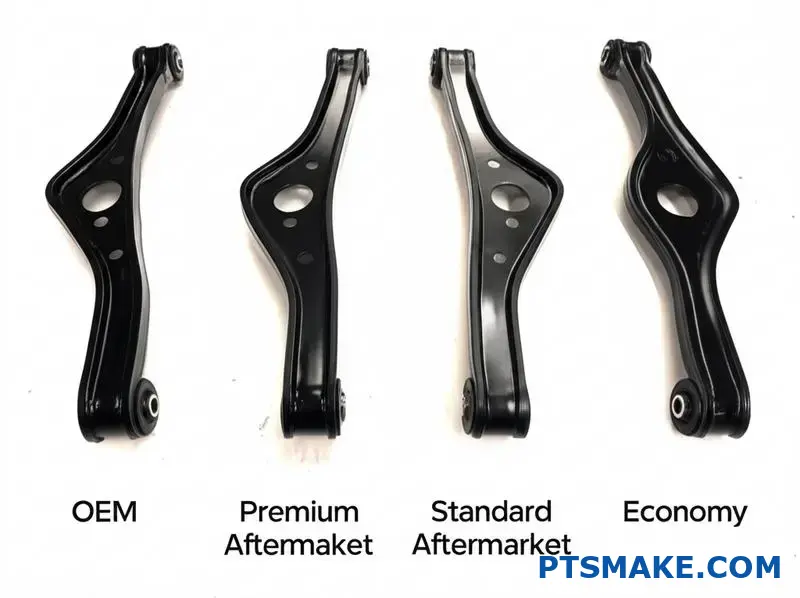
Front vs. Rear Control Arm Differences
Location matters significantly when calculating control arm replacement costs:
Front Control Arms:
- Generally more expensive to replace (25-40% higher costs)
- Usually bear more weight and encounter greater forces
- Often integrated with more components (ball joints, bushings, stabilizer links)
- Directly impact steering, requiring precise installation and alignment
Rear Control Arms:
- Typically simpler design with fewer integrated components
- Usually easier to access and replace
- May not require as precise alignment adjustments
- Often less expensive as parts
However, these generalizations can flip completely depending on vehicle design. For example, some European vehicles have relatively simple front control arms but extraordinarily complex rear multi-link suspensions with numerous control arms per wheel.
DIY vs. Professional Replacement
For the mechanically inclined, DIY control arm replacement can offer significant cost savings:
Professional Shop Costs (Average):
- Parts: $150-$400 per control arm
- Labor: $100-$300 per side
- Alignment: $80-$150
- Total: $330-$850
DIY Costs (Average):
- Parts: $150-$400 per control arm
- Alignment: $80-$150 (still needed professionally)
- Tool rental/purchase: $50-$100 (if you don’t already own them)
- Total: $280-$650
While DIY replacement can save money, I always caution customers about several important considerations:
- Specialized tools: Many control arm replacements require ball joint separators, presses, and/or specific socket sizes
- Safety concerns: Working with suspension components requires proper vehicle support and understanding of preloaded components
- Difficulty level: Rated moderate to advanced, not recommended for beginners
- Time commitment: What takes a professional 1-2 hours might take an inexperienced DIYer an entire day
The cost calculation should also include the value of your time and the potential for additional costs if something goes wrong during a DIY attempt. I’ve seen many DIY projects end up costing more when customers ultimately needed professional assistance to fix problems encountered during their repair attempts.
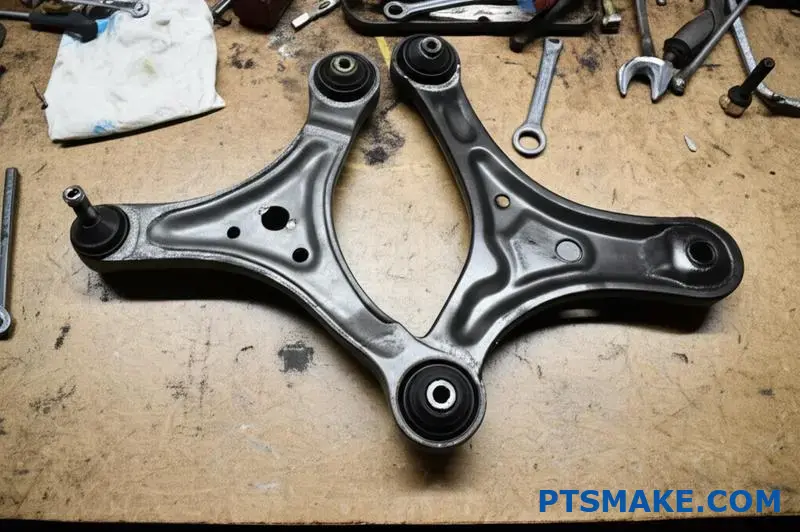
How to Save Money on Control Arm Replacement
Based on my experience in the industry, here are practical ways to reduce your control arm replacement costs without compromising quality:
Obtain Multiple Quotes
Prices can vary dramatically between repair shops. I recommend:
- Getting quotes from at least three different repair facilities
- Comparing dealership, independent, and specialty shop prices
- Asking what brand of parts each shop plans to use
- Inquiring whether they’ll use new or remanufactured components
Many shops are willing to install customer-supplied parts, though they typically won’t warranty parts they didn’t provide. This approach can save 20-30% on parts costs if you source quality components.
Consider Partial Replacement
In some cases, full control arm replacement isn’t necessary:
- Some control arms allow bushings to be replaced separately (saving 40-60%)
- Ball joints can sometimes be replaced individually rather than replacing the entire arm
- If multiple control arms need replacement, prioritizing those showing the most wear can spread costs over time
However, this approach isn’t always recommended. If bushings are worn, other components may also be nearing the end of their service life. Sometimes complete replacement provides better value when considering labor overlap.
Timing and Maintenance
Strategic timing can lower your overall costs:
- Combining control arm replacement with other scheduled maintenance reduces labor overlap
- Addressing minor control arm issues before they cause damage to other components (tires, ball joints, etc.)
- Performing preventative maintenance like lubricating ball joints (where applicable) to extend component life
I’ve consistently observed that proactive suspension maintenance costs significantly less than reactive repairs after complete failures occur.
Signs It’s Time to Replace Control Arms
Identifying control arm issues early can prevent more expensive repairs later. Watch for these warning signs:
Unusual noises:
- Clunking sounds when going over bumps
- Popping noises during steering
- Squeaking during suspension movement
Driving symptoms:
- Steering wheel vibration
- Vehicle pulling to one side
- Loose or wandering steering feel
- Excessive bouncing after bumps
Visual indicators:
- Uneven or premature tire wear
- Visibly damaged or cracked control arms
- Torn or deteriorated bushings
- Leaking ball joint boots
Failed inspection points:
- Excessive play in ball joints
- Bushings separated from mounting points
- Bent or damaged control arm
When manufacturing precision components4 at PTSMAKE, we understand how critical properly functioning control arms are to vehicle safety and performance. Even minor control arm issues can lead to unpredictable handling and accelerated wear of other components.
Long-Term Cost Considerations
When evaluating control arm replacement costs, consider these long-term factors:
- Quality impacts longevity: Premium parts typically last 2-3 times longer than economy options
- Preventative replacement saves money: Replacing control arms before complete failure prevents damage to other components
- Alignment is non-negotiable: Skipping alignment after replacement causes expensive tire wear and handling problems
- Paired replacement often makes sense: Even if only one control arm shows symptoms, its partner on the opposite side has experienced identical stresses and may fail soon
Investing in quality control arm replacement now often proves more economical than choosing the cheapest option and needing to repeat the repair sooner. I’ve helped many clients analyze the total cost of ownership, demonstrating how higher-quality components provide better long-term value despite higher initial prices.
How Do Custom Control Arms Improve Vehicle Handling?
Have you ever felt your car’s steering feel vague or noticed excessive body roll when cornering? Perhaps you’ve experienced that unsettling float over bumps at highway speeds? Many drivers live with these handling issues, assuming they’re just characteristics of their vehicle they must accept.
Custom control arms improve vehicle handling by reducing flex, providing more precise wheel control, and allowing for geometry adjustments that factory arms can’t offer. They typically use stronger materials like billet aluminum or chromoly steel and feature upgraded bushings or bearings that eliminate slop in the suspension system.

Understanding How Control Arms Affect Vehicle Handling
Control arms are critical suspension components that connect your vehicle’s frame to the steering knuckles and wheel hubs. They control the up-and-down movement of the wheels while maintaining proper alignment. Having worked extensively with suspension systems, I can tell you that these components have a profound impact on how your vehicle handles in virtually every driving situation.
The primary functions of control arms in relation to handling include:
- Maintaining precise wheel alignment during suspension travel
- Controlling the suspension geometry through various driving conditions
- Absorbing and dampening road impacts
- Transferring steering inputs accurately to the wheels
- Resisting chassis flex during cornering
Factory control arms are designed to balance comfort, durability, cost, and handling. This compromise often means they prioritize comfort and noise reduction over maximum performance. Custom control arms, however, can be engineered to emphasize handling precision with less concern for other factors.
Material Strength and Rigidity
One of the most significant ways custom control arms improve handling is through enhanced material strength and rigidity.
| Material | Common Use | Strength Properties | Weight | Impact on Handling |
|---|---|---|---|---|
| Stamped Steel | Most OEM arms | Moderate strength, some flex | Heavier | Less precise wheel control |
| Cast Aluminum | Some OEM arms | Good strength, moderate flex | Medium | Better than steel, still has flex |
| Billet Aluminum | Premium custom arms | Excellent strength, minimal flex | Light | Sharp, responsive handling |
| Chromoly Steel | Racing custom arms | Superior strength, minimal flex | Medium | Excellent wheel control, slightly heavier |
| Carbon Fiber | Ultra-premium custom | Extraordinary strength-to-weight | Lightest | Exceptional responsiveness, reduced unsprung weight |
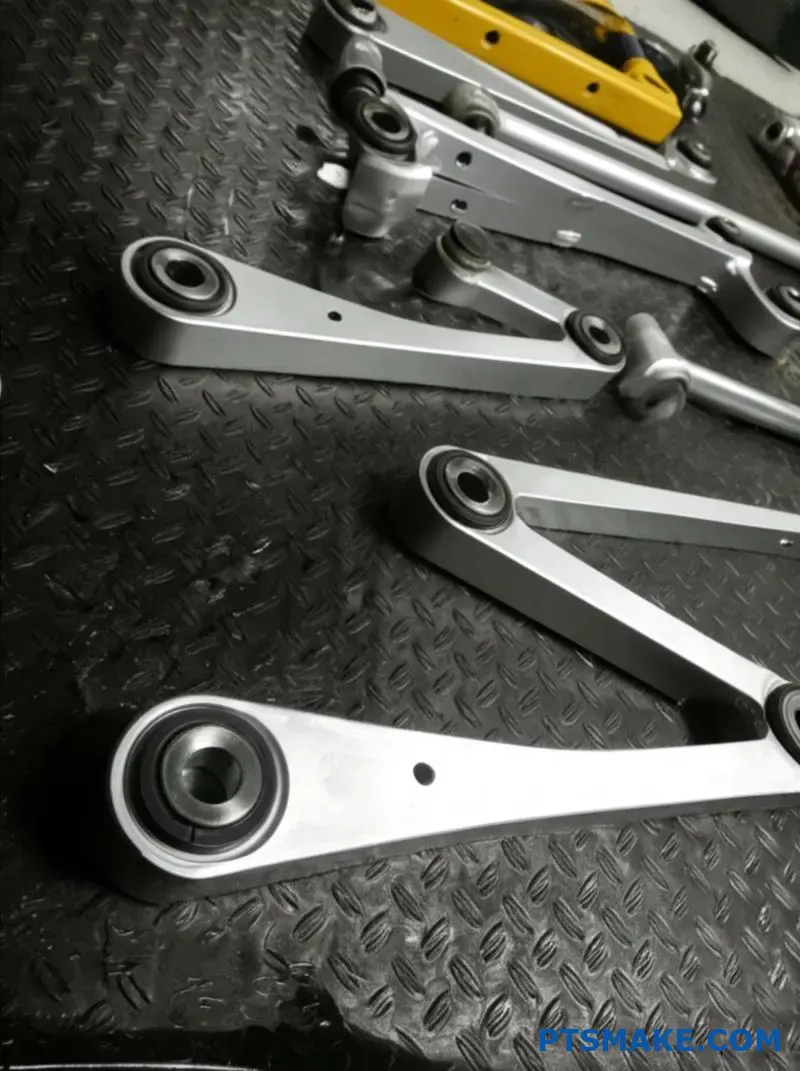
When control arms flex during cornering or over bumps, they momentarily change your suspension geometry. This flex creates unpredictable handling characteristics and delayed response. Custom control arms made from materials like billet aluminum or chromoly steel resist this flexing, maintaining consistent geometry and providing more immediate feedback to the driver.
I’ve installed custom control arms on numerous customer vehicles, and the difference in steering precision is often immediately noticeable, especially during quick directional changes. The car responds more predictably because the wheels maintain their intended position relative to the chassis.
Enhanced Bushing Performance
The bushings where control arms connect to the frame and wheel assemblies significantly impact handling characteristics. Factory control arms typically use soft rubber bushings prioritizing noise reduction and comfort over performance.
Custom control arms often feature:
Polyurethane Bushings
These bushings offer a middle ground between rubber and solid mountings. They provide:
- 30-50% less deflection than rubber
- Better durability in extreme conditions
- Sharper steering response
- Some increase in vibration transfer
Spherical Bearings or Rod Ends
For maximum performance, these eliminate bushing deflection entirely:
- Zero deflection under load
- Immediate transfer of inputs
- Complete elimination of bushing compliance
- Significant increase in NVH (noise, vibration, harshness)
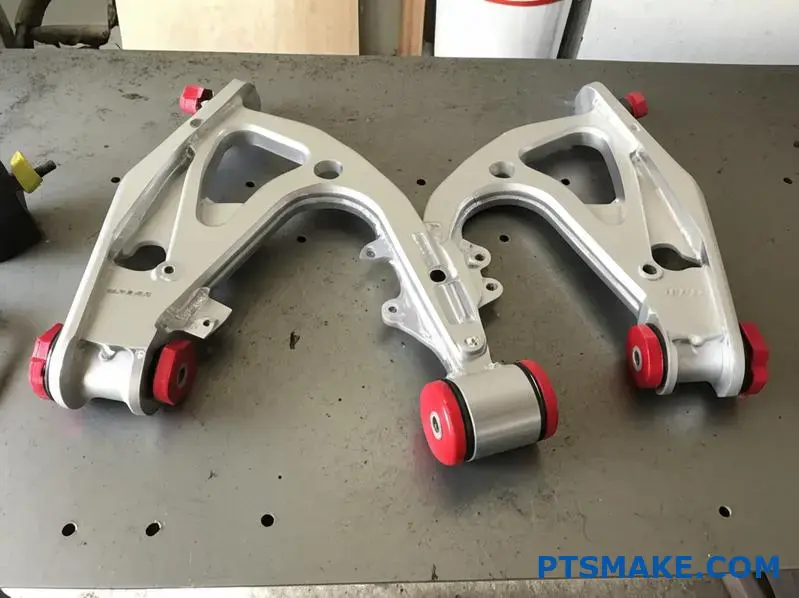
This reduction in bushing deflection translates directly to handling improvements. When you turn the steering wheel, the input transfers more immediately to the wheels rather than being partially absorbed by soft bushings. The result is more precise steering and better feedback through the wheel.
Adjustability for Optimized Geometry
Perhaps the most valuable handling benefit of custom control arms is their adjustability. Factory arms lock you into predetermined suspension geometry, but custom adjustable control arms allow fine-tuning of:
Camber Adjustment
Camber refers to the vertical tilt of the wheels when viewed from the front. Adjustable custom control arms allow you to:
- Optimize tire contact patch during cornering
- Compensate for lowered suspension
- Fine-tune handling characteristics for different driving conditions
- Reduce inner or outer tire wear
Caster Adjustment
Caster affects straight-line stability and steering effort. Custom arms with caster adjustment provide:
- Improved straight-line tracking
- Adjusted steering effort to driver preference
- Better stability at high speeds
- Enhanced self-centering of the steering
Roll Center Correction
For modified vehicles, custom control arms can restore proper roll center height, which:
- Reduces body roll during cornering
- Improves weight transfer characteristics
- Maintains proper suspension geometry on lowered vehicles
- Enhances overall handling balance
At PTSMAKE, we’ve helped design custom control arms that address specific handling issues that standard components couldn’t solve. This level of customization allows for truly optimized handling characteristics tailored to specific vehicles and driving styles.
Real-World Handling Improvements
The theoretical benefits of custom control arms translate to several measurable real-world handling improvements:
Reduced Body Roll
Body roll during cornering can make a vehicle feel unstable and reduce driver confidence. Custom control arms help reduce body roll by:
- Maintaining more consistent suspension geometry
- Eliminating bushing deflection that allows additional roll
- Allowing for optimized camber curves that keep tires more squarely on the road
For performance-oriented drivers, this reduction in body roll means faster cornering speeds and more predictable handling at the limit.
Improved Steering Response
Steering precision is perhaps the most immediately noticeable benefit of custom control arms. The improvements include:
- Reduced delay between steering input and vehicle response
- More linear steering feel throughout the range of motion
- Better feedback through the steering wheel
- Elimination of vague on-center feel common with soft bushings
These improvements make the vehicle feel more connected to the driver and inspire greater confidence, especially in high-speed driving scenarios.
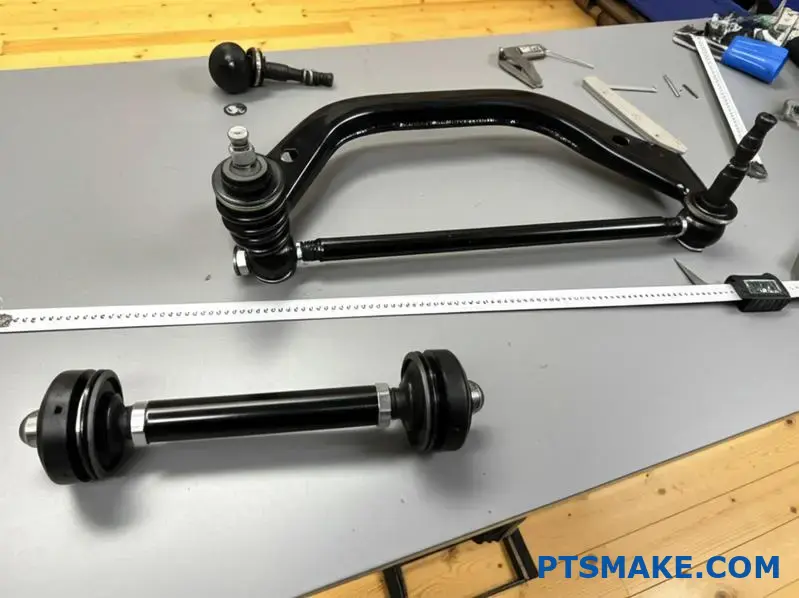
Better Bump Absorption and Recovery
While it might seem counterintuitive, stiffer control arms can actually improve how a vehicle handles bumps and road imperfections. This occurs because:
- The wheel maintains more consistent geometry through the bump
- The suspension recovers more quickly after compression
- There’s less secondary movement (oscillation) after the initial impact
- Weight transfer happens more predictably during bumpy cornering
These characteristics are particularly valuable on track days or spirited driving on imperfect road surfaces, where maintaining control over uneven terrain becomes critical.
Enhanced Tire Contact and Grip
Perhaps the most significant performance benefit comes from improved tire contact with the road. Custom control arms help maximize grip by:
- Maintaining optimal camber angles during body roll
- Reducing unwanted changes in toe angle during suspension compression
- Providing more consistent loading across the tire contact patch
- Minimizing alignment changes during hard cornering
This improved tire contact directly translates to higher cornering limits and better traction during acceleration and braking.
Considerations Before Upgrading
While custom control arms offer substantial handling benefits, they’re not ideal for every situation. Consider these factors before upgrading:
- Intended use: Track-focused setups may be too harsh for daily driving
- Existing modifications: Custom arms work best as part of a cohesive suspension package
- Budget constraints: Quality custom arms require significant investment
- Maintenance requirements: Some designs require regular inspection and maintenance
- Noise and comfort trade-offs: Improved handling often comes with increased NVH
I always advise customers to clearly define their performance goals and honestly assess how they use their vehicle before committing to custom control arms. The ideal setup for a dedicated track car differs dramatically from what works best on a daily driver that sees occasional spirited driving.
Well-designed custom control arms represent one of the most effective handling upgrades available, providing improvements in virtually every aspect of vehicle dynamics. When properly matched to your vehicle and driving style, they transform not only objective performance metrics but also the subjective feeling of connection between driver and machine.
For vehicles with modified ride height or other suspension changes, custom control arms often become a necessity rather than an option to restore proper handling characteristics. In these cases, the investment isn’t just about improving performance—it’s about correcting potentially dangerous handling compromises created by other modifications.
What Materials Are Best For Custom Control Arms?
Have you ever felt your car handle poorly over bumps or noticed increased wear on your tires? These issues might stem from inadequate control arms. Many drivers tolerate subpar handling and performance because they’re unaware that upgrading to custom control arms made from superior materials could transform their driving experience.
The best materials for custom control arms include 7075-T6 and 6061-T6 billet aluminum for lightweight performance applications, 4130 chromoly steel for strength and durability in high-stress situations, carbon fiber for elite lightweight needs, and forged steel for heavy-duty applications. The ideal material depends on your specific vehicle usage, performance requirements, and budget.
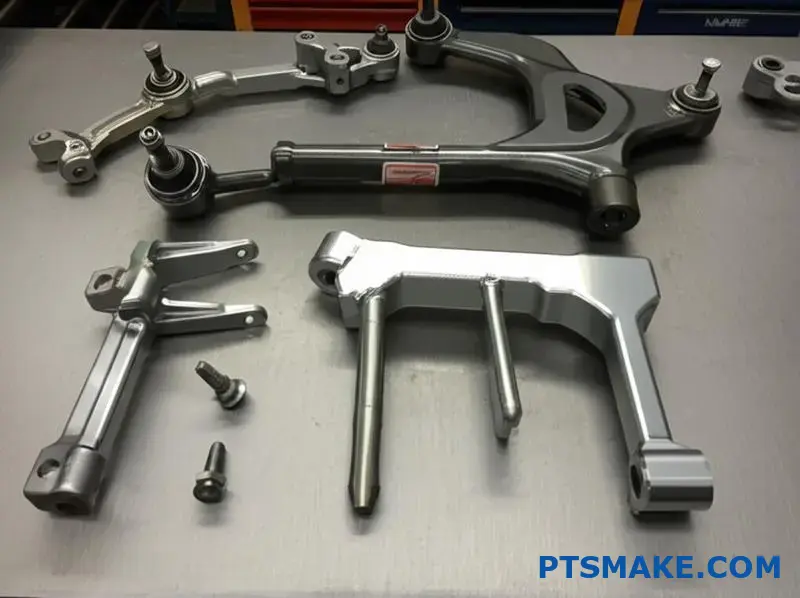
Material Options for Custom Control Arms
When it comes to selecting materials for custom control arms, the options can seem overwhelming. Each material offers different benefits that directly impact handling, durability, and overall performance. After years of experience manufacturing custom suspension components, I’ve developed a comprehensive understanding of how different materials perform in real-world conditions.
Aluminum Alloys
Aluminum alloys represent the most popular choice for custom control arms, offering an excellent balance of weight, strength, and corrosion resistance.
6061-T6 Aluminum
This is perhaps the most commonly used aluminum alloy for custom control arms:
- Excellent machinability for intricate designs
- Good strength-to-weight ratio
- Superior corrosion resistance
- Cost-effective compared to other premium materials
- Moderate fatigue resistance
The T6 designation indicates heat treatment that significantly improves strength. While not as strong as some alternatives, 6061-T6 provides sufficient strength for most street applications and mild performance use while keeping weight down.
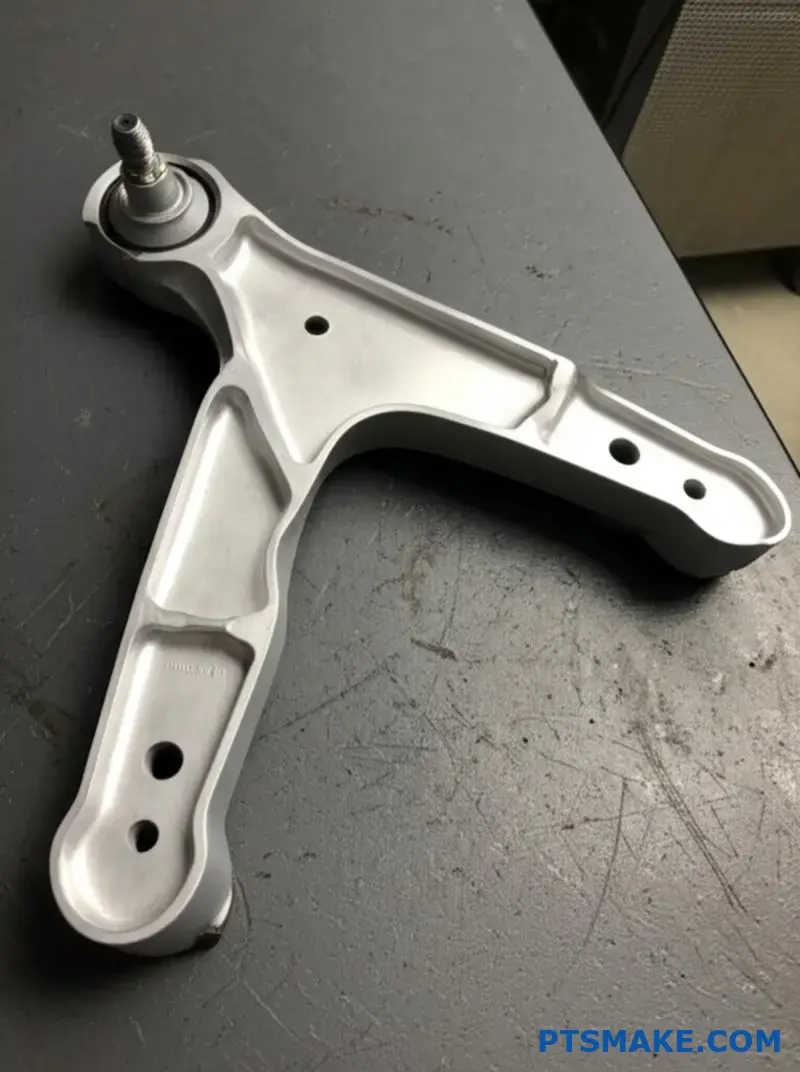
7075-T6 Aluminum
For more demanding applications, 7075-T6 aluminum offers significant advantages:
- Approximately 60% stronger than 6061-T6
- Better fatigue resistance for high-stress applications
- Still maintains excellent weight advantage over steel
- Superior resistance to stress cracking
- Used in aerospace applications for its reliability
The downside is that 7075-T6 is more expensive and slightly more difficult to machine. For serious performance applications where weight matters, this material often represents the sweet spot between performance and cost.
| Material | Tensile Strength (psi) | Weight (relative) | Cost | Best Application |
|---|---|---|---|---|
| 6061-T6 Aluminum | 45,000 | Light (1.0) | Moderate | Street/Mild Performance |
| 7075-T6 Aluminum | 83,000 | Light (1.0) | High | Performance/Track |
| 4130 Chromoly | 97,000 | Heavy (2.9) | Moderate | Heavy-Duty/Off-Road |
| Forged Steel | 110,000+ | Very Heavy (3.0) | Moderate | Heavy Trucks/Extreme Use |
| Carbon Fiber | 500,000+ | Ultra-Light (0.5) | Very High | Elite Performance/Racing |
Steel Variants
Steel offers exceptional strength but comes with a weight penalty. There are several steel options for custom control arms:
4130 Chromoly Steel
Also known as chrome-molybdenum steel, this alloy offers:
- Exceptional strength under load
- Superior resistance to fatigue and stress fractures
- Excellent weldability for tubular designs
- Better strength-to-weight ratio than mild steel
- Good impact resistance
For off-road applications or vehicles that experience significant suspension loads, chromoly steel represents an excellent choice despite the weight penalty compared to aluminum. The tubular construction method often used with chromoly helps mitigate some of the weight disadvantage.
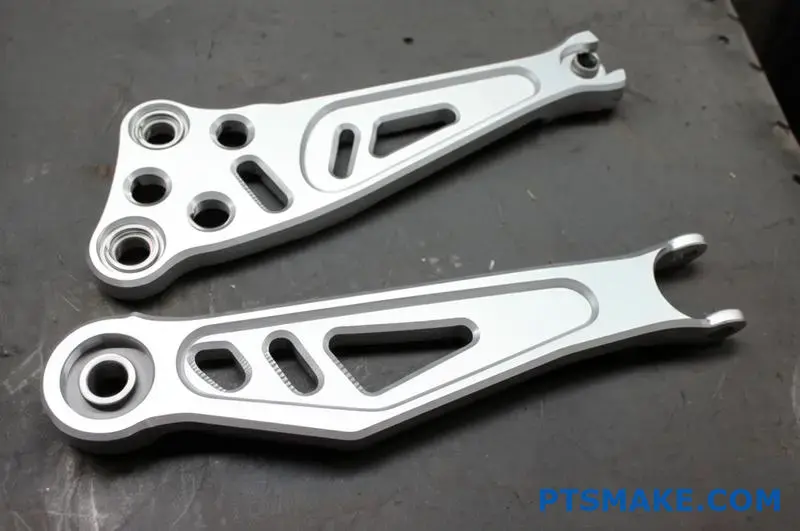
Forged Steel
For the most extreme applications or heavy vehicles:
- Maximum strength and durability
- Superior resistance to bending under extreme loads
- Excellent longevity in harsh conditions
- Better grain structure than cast steel
- Appropriate for heavy trucks and SUVs
The significant weight penalty makes forged steel less suitable for performance applications where handling and responsiveness are priorities. However, for heavy-duty applications where durability is paramount, forged steel control arms provide unmatched reliability.
Advanced Composite Materials
For specialized applications where cost is less of a concern:
Carbon Fiber Composites
Representing the cutting edge of control arm materials:
- Exceptional strength-to-weight ratio
- Significantly reduces unsprung weight
- Can be engineered for specific load characteristics
- Supreme fatigue resistance
- Dramatic weight savings (up to 70% lighter than steel)
The primary limitation of carbon fiber is cost, which can be 3-5 times higher than premium aluminum options. Additionally, carbon fiber components require specialized manufacturing processes that few companies can execute properly for structural suspension components.
Material Selection Based on Application
The best material for your custom control arms depends largely on how you use your vehicle. Here’s my recommendation based on different applications:
Street Performance
For daily drivers with occasional spirited driving:
- Recommended: 6061-T6 aluminum
- Why: Offers a good balance of weight savings, strength, corrosion resistance, and cost
- Considerations: Pair with polyurethane bushings for improved responsiveness while maintaining acceptable NVH levels
Track/Competition
For vehicles that see regular track use:
- Recommended: 7075-T6 aluminum or carbon fiber (budget permitting)
- Why: Maximizes performance through weight reduction while maintaining necessary strength
- Considerations: Often paired with spherical bearings for zero deflection during high-load cornering
Off-Road Use
For vehicles tackling rough terrain:
- Recommended: 4130 chromoly steel in tubular design
- Why: Provides superior impact resistance and durability in unpredictable conditions
- Considerations: The additional strength is worth the weight penalty when rock strikes or landing from jumps are concerns
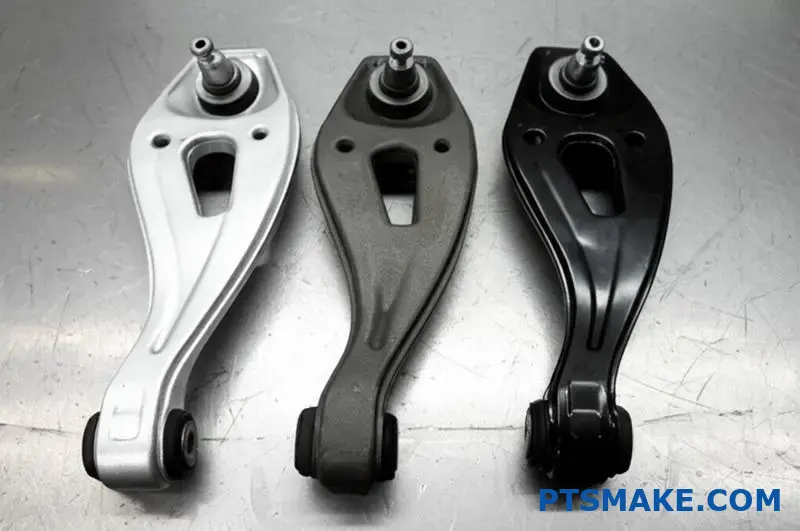
Heavy Vehicles
For trucks, SUVs, and heavily modified vehicles:
- Recommended: Forged steel or heavy-gauge chromoly
- Why: Can withstand extreme loads without deformation
- Considerations: The weight penalty is less significant relative to the overall vehicle weight
Manufacturing Methods and Their Impact
The material itself is only part of the equation—how custom control arms are manufactured significantly affects their performance:
Billet Construction
Common with aluminum control arms:
- CNC machined from solid blocks of material
- Allows for precise design optimization
- Eliminates weak points found in welded construction
- Enables complex geometries for optimized strength
- Often more aesthetically pleasing
At PTSMAKE, we’ve refined our CNC machining processes to produce billet aluminum control arms with exceptional dimensional precision, which is critical for maintaining consistent suspension geometry.
Tubular Construction
Frequently used with steel control arms:
- Welded tubes create a truss-like structure
- Optimizes strength-to-weight ratio for steel
- Allows for larger diameters without proportional weight increase
- Can be engineered for specific load paths
- Often rebuildable if damaged
Hybrid Designs
Combining manufacturing methods:
- Machined mounting points welded to tubular main sections
- Combines the precision of billet with the strength of tubular design
- Often represents the best compromise for specific applications
- Allows for easier integration of adjustment mechanisms
Bushing Selection to Complement Material Choice
The bushing type used in custom control arms is almost as important as the arm material itself:
Rubber Bushings
- Complement any control arm material where comfort is a priority
- Absorb vibration and road noise
- Provide progressive resistance to movement
- Less precise than performance alternatives
- Longest service life in normal conditions
Polyurethane Bushings
- Pair well with aluminum control arms for street performance
- Offer 30-50% less deflection than rubber
- Transmit more road feel to the driver
- Balance performance and comfort
- Require regular lubrication
Spherical Bearings
- Often used with high-strength materials for maximum performance
- Eliminate all bushing deflection
- Provide immediate response to suspension inputs
- Transmit significantly more noise and vibration
- Require regular maintenance and inspection
Cost Considerations in Material Selection
Material choice significantly impacts the cost of custom control arms:
- 6061-T6 Aluminum: Most cost-effective premium option (baseline)
- 4130 Chromoly Steel: 10-20% more expensive than basic 6061-T6
- 7075-T6 Aluminum: 40-60% more expensive than 6061-T6
- Forged Steel: Varies widely depending on production volume
- Carbon Fiber: 200-400% more expensive than 6061-T6
When advising clients at PTSMAKE about material selection, I always emphasize value rather than absolute cost. For example, 7075-T6 aluminum may cost more initially but offers significantly better longevity in high-stress applications, potentially providing better long-term value despite the higher purchase price.
Longevity and Maintenance Requirements
Different materials require different maintenance approaches:
- Aluminum Alloys: Excellent corrosion resistance but may require periodic inspection for fatigue cracks in high-stress applications
- Chromoly Steel: Requires proper finishing (powder coating, zinc plating, etc.) to prevent rust and should be inspected for corrosion
- Carbon Fiber: Requires inspection for delamination or damage, as failures can occur without visible warning
- Forged Steel: Most maintenance-free but heaviest option
For trackday enthusiasts and serious performance drivers, I recommend establishing a regular inspection schedule regardless of material choice. The extreme loads experienced during performance driving can accelerate wear on any material.
Control arms made from superior aircraft-grade materials5 like 7075-T6 aluminum or 4130 chromoly steel transform vehicle handling by maintaining precise suspension geometry under load. When properly matched to your specific application, these materials provide tangible improvements in steering response, cornering stability, and overall driver confidence.
How To Verify Quality Standards For Custom Control Arms?
Have you struggled to determine if those custom control arms you’re considering are worth the investment? Many vehicle owners face this dilemma, unsure of how to assess quality beyond glossy marketing claims, leaving them vulnerable to purchasing inferior components that could compromise vehicle safety and performance.
To verify quality standards for custom control arms, examine material certification, manufacturing precision, surface finish quality, proper heat treatment, bushing/bearing quality, and thorough testing documentation. Quality control arms should include detailed specifications, undergo dimensional inspection, hardness testing, and load testing to verify they meet or exceed OEM strength requirements.

Essential Quality Verification Methods for Custom Control Arms
When evaluating custom control arms, understanding proper verification methods separates high-quality components from inferior ones. After examining thousands of control arms throughout my career, I’ve developed a systematic approach to quality verification that ensures safety and performance.
Material Certification and Verification
The foundation of any quality control arm begins with the material itself. Proper material verification should include:
Material Composition Analysis
Reputable manufacturers should provide material certification showing:
- Exact alloy composition (percentages of each element)
- Heat or batch number for traceability
- Mill certification from the raw material supplier
- Verification of material grade (6061-T6, 7075-T6, 4130 chromoly, etc.)
These certifications aren’t just paperwork—they confirm the material meets the claimed specifications. At PTSMAKE, we maintain complete material traceability from raw stock to finished product.
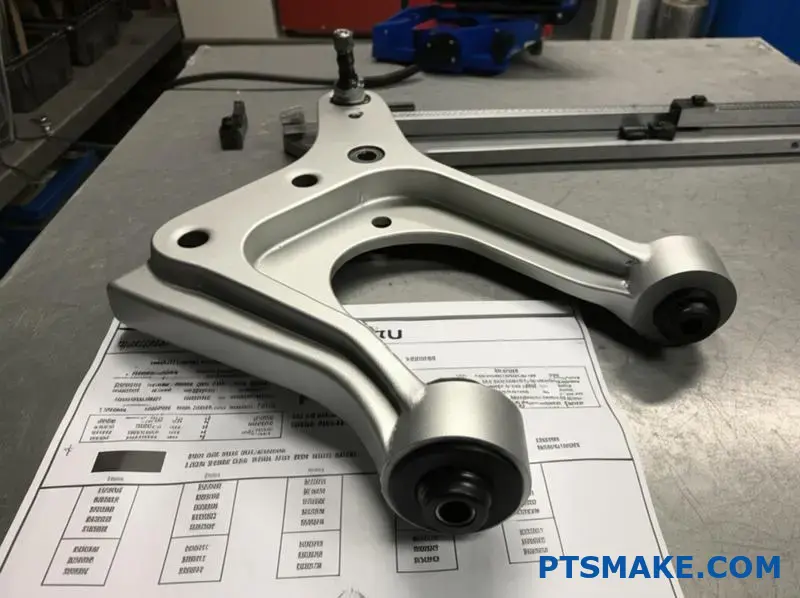
Heat Treatment Verification
For materials requiring heat treatment (like T6 aluminum or properly quenched/tempered steel):
- Heat treatment certification showing process parameters
- Hardness testing results (typically Rockwell scale)
- Documentation of heat treatment facility certification
- Before/after mechanical property verification
| Material | Expected Hardness Range | Test Method | Critical for Performance |
|---|---|---|---|
| 6061-T6 Aluminum | 95-105 HB | Brinell | Yes – Affects strength and fatigue life |
| 7075-T6 Aluminum | 150-160 HB | Brinell | Critical – Determines load capacity |
| 4130 Steel (Q&T) | 28-32 HRC | Rockwell C | Yes – Prevents premature failure |
| Carbon Steel | 55-60 HRC | Rockwell C | Critical – Ensures durability |
Improper heat treatment can reduce material strength by 40-60%, making verification essential. I’ve seen many failures where the material was correct but improperly heat-treated, resulting in premature deformation under load.
Manufacturing Precision Assessment
Custom control arms require exceptionally precise manufacturing to maintain proper suspension geometry.
Dimensional Inspection Reports
Quality manufacturers should provide:
- Coordinate measuring machine (CMM) reports showing critical dimensions
- Comparison to CAD design specifications with tolerance ranges
- Mounting hole location verification (typically ±0.1mm or better)
- Bushing/bearing bore size and geometry certification
These measurements ensure the control arm will maintain proper suspension geometry when installed. Even small deviations can cause significant handling problems and accelerated tire wear.
Surface Finish Evaluation
Surface quality directly impacts fatigue resistance and longevity:
- Machined surfaces should have specified roughness values (typically Ra 32-125 for billet parts)
- No tool chatter marks or machining defects
- Proper edge breaking to prevent stress risers
- Smooth transitions between different features
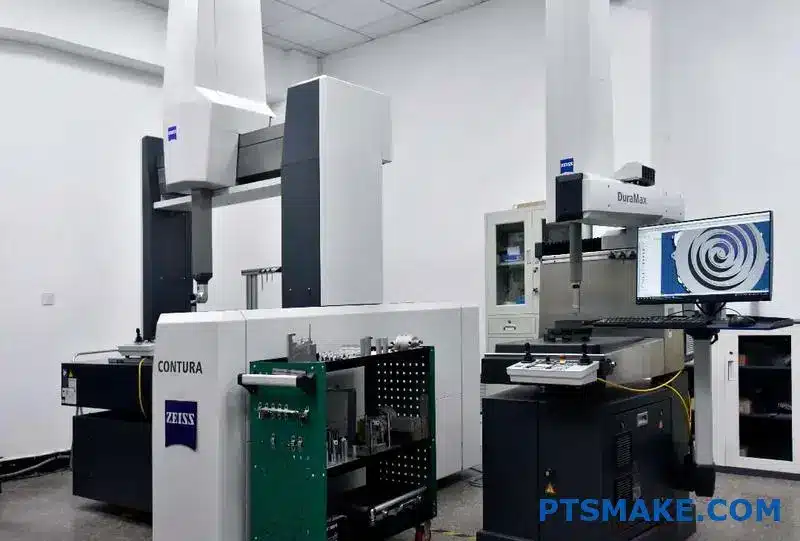
During my time at PTSMAKE, I’ve rejected components with excellent dimensional accuracy but poor surface finish, as these would inevitably develop fatigue cracks prematurely.
Structural Integrity Testing
Beyond material and manufacturing quality, control arms must undergo proper structural testing.
Non-Destructive Testing Methods
For critical applications, look for these testing certifications:
- Dye penetrant testing for surface cracks
- Ultrasonic testing for internal defects in forgings
- X-ray inspection for welded assemblies
- Magnetic particle inspection for ferrous materials
These tests identify flaws invisible to the naked eye that could lead to catastrophic failure during use.
Load Testing Protocols
Quality control arms should undergo load testing that:
- Simulates or exceeds real-world forces
- Verifies yield strength meets design specifications
- Includes cycling testing for fatigue resistance
- Documents both static and dynamic load capacity
The most reputable manufacturers conduct destructive testing on sample parts from each production batch to verify strength consistency. This testing should simulate multiple load scenarios, not just simple tensile testing.
Bushing and Bearing Quality Assessment
The connection points are often the weakest link in control arm design.
Bushing Material Verification
For rubber or polyurethane bushings:
- Durometer (hardness) testing results
- Material composition certification
- Compression set resistance data
- Environmental resistance testing (temperature, chemicals, etc.)
Bushing quality dramatically affects both performance and longevity. Inferior bushings may seem acceptable initially but will rapidly deteriorate under real-world conditions.
Bearing Quality for Performance Applications
For control arms using spherical bearings:
- Bearing load rating certification
- Material composition documentation
- Surface hardness testing of races
- Radial play measurement data
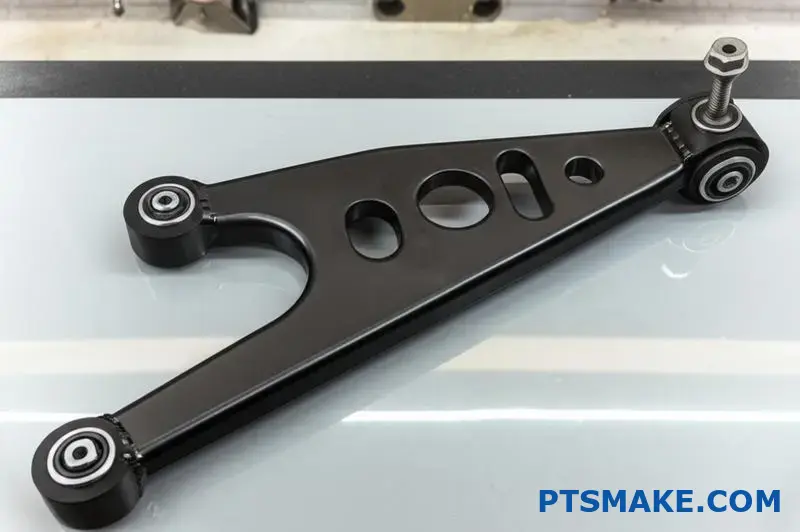
High-quality bearings should include proper sealing, appropriate clearances, and materials selected for the specific application environment. The difference between premium and economy bearings becomes apparent after just a few thousand miles in demanding conditions.
Documentation and Certification Standards
Comprehensive documentation provides evidence of quality control throughout the manufacturing process.
Manufacturing Documentation
Quality control arms should include:
- Complete bill of materials with material specifications
- Manufacturing process documentation
- Quality control inspection points and results
- Batch or serial number for traceability
This documentation allows for tracking if issues arise and confirms the manufacturer follows consistent processes.
Performance Testing Results
Beyond basic strength testing, comprehensive performance evaluation should include:
- Finite Element Analysis (FEA) results showing stress distribution
- Comparison to OEM design in strength and durability
- Suspension geometry impact analysis
- Fatigue life estimation under various load conditions
Many manufacturers claim "stronger than OEM" without quantifying this. Proper testing documentation should specify exactly how much stronger and under what conditions.
Compliance Certifications
Depending on the application, look for:
- ISO 9001 manufacturing facility certification
- Material compliance with applicable standards (ASTM, SAE, etc.)
- Engineering certification by qualified personnel
- Relevant industry association approvals (SEMA, etc.)
These certifications indicate the manufacturer adheres to recognized quality standards throughout their operation, not just for final inspection.
Practical Verification Methods for Buyers
While manufacturers should provide comprehensive documentation, buyers can also perform their own verification:
- Visual inspection: Look for precise machining, consistent finish, and proper markings
- Weight comparison: Verify the part matches claimed weight (indicating proper material density)
- Dimensional verification: Check critical mounting dimensions with precision calipers
- Finish quality: Examine surface finish consistency and edge quality
- Installation fit: Proper high-quality parts should install with precise fitment
For significant investments in high-performance parts, consider requesting material certification or even independent testing of a sample. While this adds cost, it provides absolute verification of quality claims.
Red Flags That Indicate Poor Quality
Based on my experience, these warning signs typically indicate substandard control arms:
- Vague material claims: "Aircraft-grade aluminum" without specific alloy designation
- Missing documentation: No material certification or testing data available
- Inconsistent finish: Variations in surface texture or color indicating poor process control
- Excessive weight deviation: Significantly lighter than comparable products (indicating material substitution)
- Sharp edges or corners: Proper designs eliminate stress concentration points
- Poor weld quality: Inconsistent welds, insufficient penetration, or excessive splatter
- Generic product images: Marketing photos that don’t match the actual product
The absence of specific technical data should always raise concerns. Quality manufacturers are proud of their engineering and willingly share detailed specifications.
Properly manufactured suspension components6 are critical for vehicle safety and performance. When evaluating custom control arms, demand comprehensive quality verification rather than relying on marketing claims or visual appearance alone. The extra diligence in verification ensures both safety and performance, preventing costly failures and delivering the handling improvements you’re investing in.
Can Custom Control Arms Extend Suspension Component Lifespan?
Have you noticed your vehicle’s handling becoming increasingly sloppy over time? Or perhaps you’re hearing those telltale clunks and squeaks when driving over bumps? Many vehicle owners resign themselves to regular suspension component replacement, unaware that upgrading to custom control arms could significantly extend the lifespan of their entire suspension system.
Custom control arms can extend suspension component lifespan by reducing flex, distributing loads more evenly, and maintaining proper alignment even under stress. Made from stronger materials like billet aluminum or chromoly steel with superior bushings, quality custom control arms minimize wear on ball joints, tie rods, and other suspension parts while improving handling characteristics.
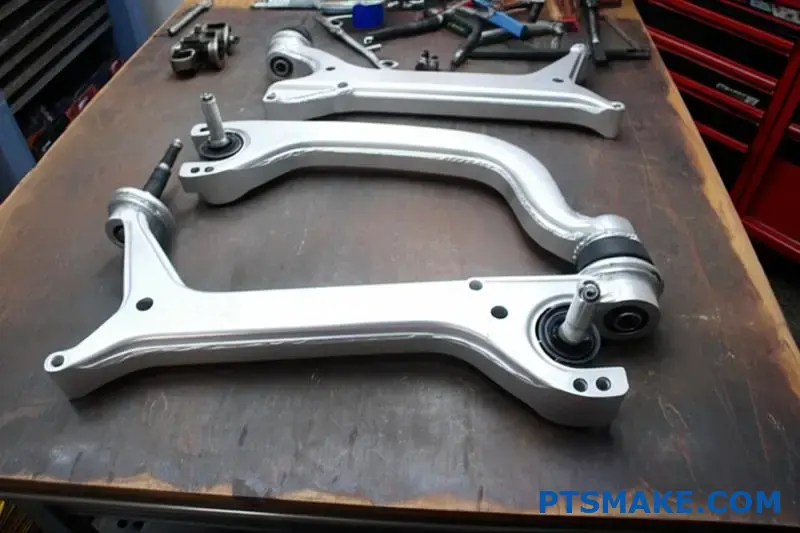
Understanding How Control Arms Impact Suspension Longevity
Control arms serve as critical links in your vehicle’s suspension system, connecting the frame to the steering knuckles and wheel hubs. They control wheel movement while maintaining proper alignment during suspension travel. As someone who has designed and manufactured custom suspension components for over 15 years, I’ve observed firsthand how control arm quality directly impacts the longevity of the entire suspension system.
The Material Advantage: Strength and Durability
Factory control arms are typically designed to balance cost, weight, and performance, often resulting in compromises. Custom control arms, by contrast, can be engineered with durability as a primary consideration.
| Material | Typical Use | Strength Properties | Impact on Component Life |
|---|---|---|---|
| Stamped Steel | Most OEM arms | Moderate strength, prone to flex | Average lifespan, gradual deformation |
| Cast Aluminum | Premium OEM | Good strength, some flex | Above-average lifespan |
| Billet Aluminum | Aftermarket | Excellent strength, minimal flex | Extended lifespan, maintains geometry |
| Chromoly Steel | Performance aftermarket | Superior strength, minimal flex | Maximum lifespan under stress |
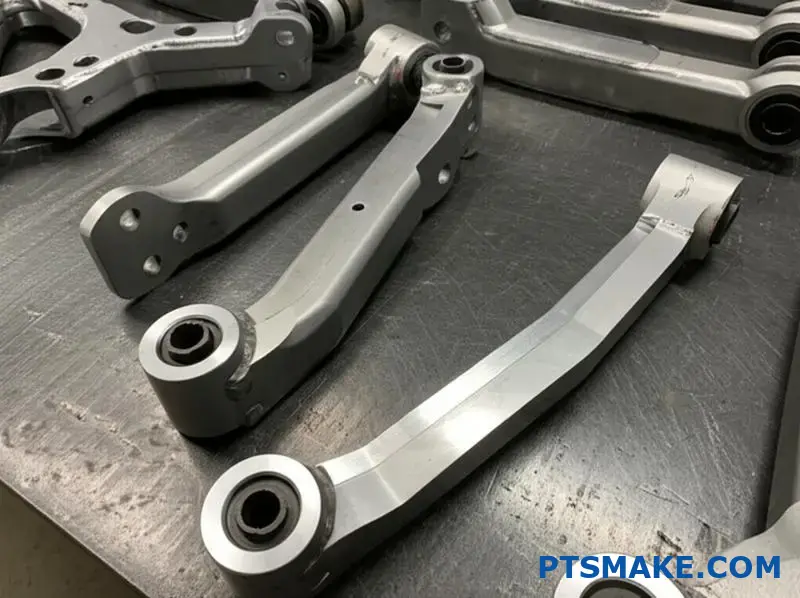
The superior materials used in quality custom control arms resist deformation under load, maintaining precise suspension geometry even after thousands of miles of driving. This consistency is crucial for extending component life since even small misalignments can create cascading wear throughout the suspension system.
When control arms flex during cornering or over bumps, they temporarily alter your suspension geometry. This fluctuation accelerates wear on connected components like ball joints, tie rod ends, and bushings. Custom control arms made from rigid materials like billet aluminum or chromoly steel dramatically reduce this flex, providing more consistent loading and significantly extending the life of these connecting parts.
Superior Bushing Technology
The bushings where control arms connect to the frame represent critical wear points in any suspension system. Factory control arms typically use rubber bushings designed for noise reduction and comfort rather than longevity.
Custom control arms often feature advanced bushing options:
Polyurethane Bushings
These offer substantial advantages for component lifespan:
- 2-3 times the lifespan of rubber bushings
- Greater resistance to deterioration from oils and road contaminants
- Better dimensional stability under load
- More consistent performance throughout their service life
Spherical Bearings
For maximum durability in performance applications:
- Eliminate bushing deflection entirely
- Provide consistent performance for the life of the component
- Can be replaced independently when worn without replacing the entire control arm
- Resist environmental degradation better than rubber or polyurethane
The improved connection points dramatically reduce the oscillation and movement that accelerate wear on both the bushings themselves and the components they connect.
Optimized Geometry and Load Distribution
Factory control arms must accommodate a wide range of driving conditions and user preferences. Custom control arms can be designed with specific load paths and geometry optimized for your vehicle’s particular setup.
Custom control arms extend component life through:
- More Even Load Distribution: Better distributing forces across connecting components
- Reduced Stress Concentrations: Eliminating design weaknesses that cause premature failures
- Optimized Motion Ratios: Ensuring smooth movement throughout the suspension travel
- Improved Alignment Stability: Maintaining precise alignment even under heavy loads
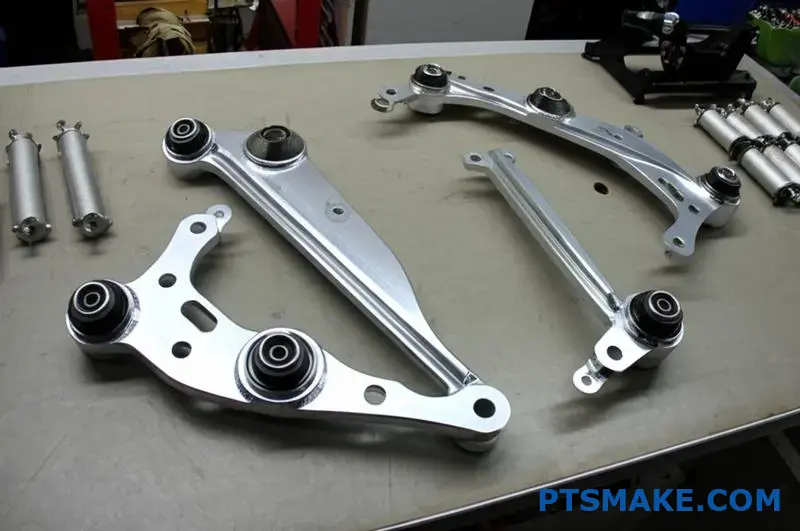
At PTSMAKE, we’ve designed custom control arms specifically engineered to address known failure points in factory suspension systems. By reinforcing these areas and redistributing loads more effectively, we’ve seen dramatic improvements in overall suspension longevity.
Measurable Benefits to Connected Components
The installation of quality custom control arms provides measurable benefits to connected suspension components:
Ball Joint Longevity
Ball joints are among the most common failure points in suspension systems. Custom control arms extend ball joint life by:
- Reducing Angular Deflection: Limiting the extreme angles that accelerate wear
- Providing More Consistent Loading: Eliminating shock loads that damage internal components
- Maintaining Proper Preload: Ensuring optimal tension throughout suspension travel
- Improving Lubrication Effectiveness: By maintaining proper alignment of seals and bearings
In real-world applications, I’ve seen ball joints last 2-3 times longer when paired with rigid, properly designed custom control arms compared to factory setups.
Tie Rod and Steering Component Wear Reduction
Your vehicle’s steering components benefit significantly from the improved geometry maintained by custom control arms:
- Consistent Steering Angles: Reducing variable loading on tie rod ends
- Eliminated Binding: Preventing the momentary binding that accelerates wear
- Reduced Feedback Forces: Minimizing damaging forces transmitted through the steering system
- Proper Alignment Under Load: Maintaining steering geometry even during cornering
These benefits translate to extended service intervals for steering components and more consistent steering feel throughout their service life.
Bearing and Hub Assembly Protection
Wheel bearings and hub assemblies suffer when suspension components allow inconsistent loading. Custom control arms protect these expensive components by:
- Maintaining Proper Wheel Alignment: Ensuring even load distribution across bearings
- Reducing Impact Forces: Better controlling wheel movement during impacts
- Eliminating Unwanted Wheel Movement: Preventing the micro-movements that cause fretting
- Distributing Braking Forces More Evenly: Reducing stress during heavy braking
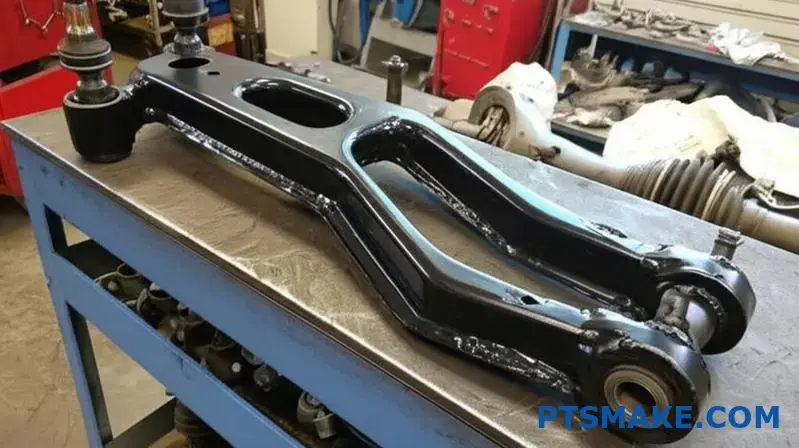
Some of our customers have reported doubling or even tripling wheel bearing life after upgrading to custom control arms, particularly in performance or heavy-duty applications.
Identifying Signs Your OEM Control Arms Are Limiting Component Life
Several warning signs indicate your factory control arms may be contributing to premature suspension wear:
- Uneven Tire Wear: Particularly wear on inner or outer edges, indicating geometry changes under load
- Frequent Bushing Replacement: Degrading more quickly than expected
- Recurring Alignment Issues: Needing alignment services more often than recommended
- Progressive Handling Deterioration: Gradually worsening steering response and precision
- Clunking or Popping Noises: Especially during initial acceleration or over bumps
If you’re experiencing these symptoms, custom control arms could address the root causes rather than just treating the symptoms.
Cost-Benefit Analysis: When Custom Control Arms Make Financial Sense
While quality custom control arms represent a significant upfront investment, they often provide long-term cost savings through reduced maintenance and component replacement:
Typical Replacement Cycles
| Component | With OEM Control Arms | With Quality Custom Control Arms | Potential Savings |
|---|---|---|---|
| Control Arm Bushings | Every 40,000-60,000 miles | 80,000-100,000+ miles or serviceable | 40-50% over vehicle life |
| Ball Joints | Every 70,000-100,000 miles | 120,000-180,000 miles | 30-45% over vehicle life |
| Wheel Bearings | Every 100,000-120,000 miles | 150,000-200,000 miles | 25-40% over vehicle life |
| Tie Rod Ends | Every 80,000-100,000 miles | 120,000-160,000 miles | 30-40% over vehicle life |
For vehicles kept long-term, the reduced frequency of component replacement often offsets the initial investment in custom control arms. This becomes even more significant for performance vehicles or those used in demanding conditions where component wear accelerates.
Applications Where Custom Control Arms Provide Maximum Benefit
Custom control arms deliver the most significant longevity improvements in specific applications:
Modified Suspension Systems
Vehicles with lowered or lifted suspensions experience the greatest benefits because:
- Factory control arms create improper geometry when ride height is altered
- Modified suspension systems place additional stress on components
- Alignment issues become more pronounced and damaging
- Custom arms can be designed specifically for the modified geometry
Performance Applications
Vehicles used for track days, autocross, or spirited driving see dramatic improvements because:
- Higher cornering forces accelerate wear on factory components
- Heat buildup during performance driving degrades factory bushings more quickly
- Repeated stress cycles reveal weaknesses in OEM designs
- Precise handling depends on maintaining consistent geometry
Heavy-Duty Use
Trucks and SUVs used for towing, hauling, or off-road driving benefit substantially from:
- Stronger materials that resist deformation under heavy loads
- Better load distribution across connecting components
- Improved articulation without binding or geometry changes
- Resistance to impacts and environmental damage
Considerations Before Upgrading
While custom control arms offer significant benefits for component longevity, consider these factors before upgrading:
- Intended Vehicle Use: Daily drivers with stock suspension may see less dramatic benefits than modified or performance vehicles
- Quality Variation: Not all aftermarket control arms are created equal; high-quality materials and precision manufacturing are essential
- Installation Expertise: Proper installation and alignment are crucial to realizing longevity benefits
- Complementary Modifications: Maximum benefit comes when control arms are part of a comprehensive suspension upgrade
- Warranty Implications: Consider how aftermarket components might affect vehicle warranties
Quality custom control arms represent one of the most effective ways to extend the life of your entire suspension system. By maintaining proper geometry, reducing flex, and using superior materials and bushings, they address the root causes of premature suspension wear rather than just the symptoms.
For vehicles you plan to keep long-term, especially those used in demanding conditions or with modified suspension, the investment in custom control arms often pays for itself through reduced maintenance costs and improved performance over time. As we often tell customers at PTSMAKE, it’s a case where "buying once, buying right" truly applies to suspension longevity7.
Learn about legal requirements for vehicle modifications and how to ensure compliance. ↩
Learn more about how proper clearance between suspension components affects performance and reliability. ↩
Click to learn about how precision manufacturing impacts suspension performance. ↩
Learn about precision manufacturing standards for critical automotive components. ↩
Learn about aerospace-grade materials that can dramatically improve your vehicle’s performance. ↩
Explore how precision machining affects suspension component quality and performance. ↩
Learn how proper suspension components significantly extend your vehicle’s service life. ↩


